Origins
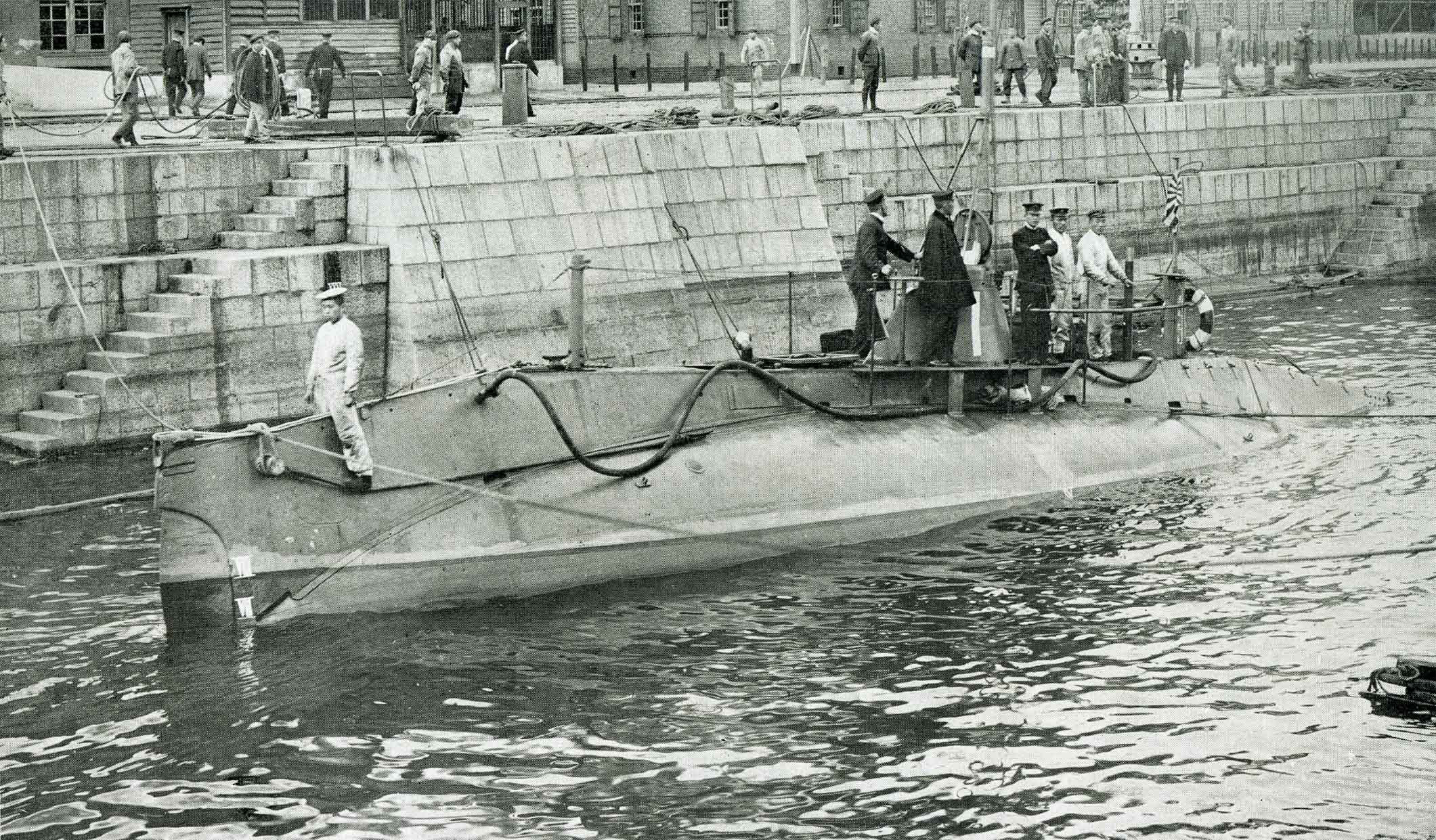
 The Imperial Japanese Navy (IJN) acquired its first submarines during the Russo-Japanese War on 12 December 1904 where they arrived in sections at the Yokohama dockyards. The vessels were purchased from the relatively new American company, General Dynamics Electric Boat, Electric Boat, and were fully assembled and ready for combat operations by August 1905.Jentschura p. 160 However, hostilities with Russian Empire, Russia were nearing its end by that date, and no submarines saw action during the war.
The submarines that Electric Boat sold to Japan were based on the USS Holland (SS-1), Holland designs, known as Holland Type VIIs similar to the American s. The five imported Hollands were originally built at Fore River Ship and Engine Company in Quincy, Massachusetts under Busch's direction for the Electric Boat Company back in August–October 1904. They were shipped by freighter from Seattle, Washington in Knock-down kit form to Japan, and then reassembled by Arthur Leopold Busch at the Yokosuka Naval Arsenal, which was then Japan's largest naval shipyard, to become Hulls No. 1 through 5 and were designated Japanese Type 1 submarine, Type 1 submarines by the Japanese Navy.
Frank Cable, an electrician who was working for Isaac Rice's Electro-Dynamic and Storage Companies along with Rice's Electric Boat, arrived some six months after Busch, training the IJN in the operation of the newly introduced vessels.
In 1904 Kawasaki Shipbuilding Corporation, Kawasaki Dockyard Company purchased plans for a modified version directly from Holland, and built two boats (Hulls No. 6 and 7), with the help of two American engineers, Chase and Herbert, who had been assistants to Holland. The Kawasaki-type submarines Displacement (ship), displaced 63 and 95 tons when submerged, and measured in Length overall, overall length, respectively. both vessels measured at the Beam (nautical), beam. This contrasted with the original five imported Hollands-type submarines which had arrived that same year, at over 100 tons submerged, in overall length and beam. The Kawasaki Type #6 and #7 submarines had gained extra speed and reduced fuel consumption by . However both boats could launch only one torpedo, and each was manned by 14 sailors, whereas the imported Holland-type submarines could fire two torpedoes and could be operated by 13 sailors. This new type was designated the Japanese Type 6 submarine, Type 6 submarine by the Imperial Japanese Navy, and was used primarily for test purposes.
The ''Kaigun Holland'' #6 was launched at Kobe on 28 September 1905 and was completed six months later at Kure as the first submarine built in Japan. It sank during a training dive in Hiroshima Bay on 15 April 1910. Although the water was only deep, there were no provisions at all for the crew to escape while submerged. The commanding officer, Lieutenant Tsutomu Sakuma, patiently wrote a description of his sailor's efforts to bring the boat back to the surface as their oxygen supply ran out. All of the sailors were later found dead at their duty stations when this submarine was raised the following day. The sailors were regarded as heroes for their calm performance of their duties until death, and this submarine was preserved as a memorial in Kure until the end of World War II.
Although the capabilities of these first submarines were never tested in combat during the Russo-Japanese War, the first submarine squadron was soon formed at Kure Naval District in the Seto Inland Sea, Inland Sea. Following the war, the Japanese government followed submarine developments by the Royal Navy with interest, and purchased two British C-class submarines directly from Vickers Shipbuilding and Engineering, Vickers, with an additional three built from kits by the Kure Naval Arsenal. These became respectively the Japanese and submarines. An additional two vessels, forming the were later built by the Kure Naval Arsenal.
In 1909, the first submarine tender, , was commissioned.
The Imperial Japanese Navy (IJN) acquired its first submarines during the Russo-Japanese War on 12 December 1904 where they arrived in sections at the Yokohama dockyards. The vessels were purchased from the relatively new American company, General Dynamics Electric Boat, Electric Boat, and were fully assembled and ready for combat operations by August 1905.Jentschura p. 160 However, hostilities with Russian Empire, Russia were nearing its end by that date, and no submarines saw action during the war.
The submarines that Electric Boat sold to Japan were based on the USS Holland (SS-1), Holland designs, known as Holland Type VIIs similar to the American s. The five imported Hollands were originally built at Fore River Ship and Engine Company in Quincy, Massachusetts under Busch's direction for the Electric Boat Company back in August–October 1904. They were shipped by freighter from Seattle, Washington in Knock-down kit form to Japan, and then reassembled by Arthur Leopold Busch at the Yokosuka Naval Arsenal, which was then Japan's largest naval shipyard, to become Hulls No. 1 through 5 and were designated Japanese Type 1 submarine, Type 1 submarines by the Japanese Navy.
Frank Cable, an electrician who was working for Isaac Rice's Electro-Dynamic and Storage Companies along with Rice's Electric Boat, arrived some six months after Busch, training the IJN in the operation of the newly introduced vessels.
In 1904 Kawasaki Shipbuilding Corporation, Kawasaki Dockyard Company purchased plans for a modified version directly from Holland, and built two boats (Hulls No. 6 and 7), with the help of two American engineers, Chase and Herbert, who had been assistants to Holland. The Kawasaki-type submarines Displacement (ship), displaced 63 and 95 tons when submerged, and measured in Length overall, overall length, respectively. both vessels measured at the Beam (nautical), beam. This contrasted with the original five imported Hollands-type submarines which had arrived that same year, at over 100 tons submerged, in overall length and beam. The Kawasaki Type #6 and #7 submarines had gained extra speed and reduced fuel consumption by . However both boats could launch only one torpedo, and each was manned by 14 sailors, whereas the imported Holland-type submarines could fire two torpedoes and could be operated by 13 sailors. This new type was designated the Japanese Type 6 submarine, Type 6 submarine by the Imperial Japanese Navy, and was used primarily for test purposes.
The ''Kaigun Holland'' #6 was launched at Kobe on 28 September 1905 and was completed six months later at Kure as the first submarine built in Japan. It sank during a training dive in Hiroshima Bay on 15 April 1910. Although the water was only deep, there were no provisions at all for the crew to escape while submerged. The commanding officer, Lieutenant Tsutomu Sakuma, patiently wrote a description of his sailor's efforts to bring the boat back to the surface as their oxygen supply ran out. All of the sailors were later found dead at their duty stations when this submarine was raised the following day. The sailors were regarded as heroes for their calm performance of their duties until death, and this submarine was preserved as a memorial in Kure until the end of World War II.
Although the capabilities of these first submarines were never tested in combat during the Russo-Japanese War, the first submarine squadron was soon formed at Kure Naval District in the Seto Inland Sea, Inland Sea. Following the war, the Japanese government followed submarine developments by the Royal Navy with interest, and purchased two British C-class submarines directly from Vickers Shipbuilding and Engineering, Vickers, with an additional three built from kits by the Kure Naval Arsenal. These became respectively the Japanese and submarines. An additional two vessels, forming the were later built by the Kure Naval Arsenal.
In 1909, the first submarine tender, , was commissioned.
World War I
Japan, along with the rest of the Allies of World War I, Allies, drew heavily upon Germany's ''Guerre de Course'' (commerce raiding) operations during the First World War, and their submarine successes reinforced Japan's willingness to develop this weapon, resulting in eighteen ocean-going submarines being included in its 1917 expansion program. Japan received nine German submarines as World War I reparations, which allowed her and the other Allies to accelerate their technological developments during the interwar period.World War II
Imperial Japanese Navy (IJN) submarines formed by far the most varied fleet of submarines of Naval history of World War II, World War II, including manned torpedoes (''Kaiten''), midget submarines (Type A Kō-hyōteki-class submarine, ''Kō-hyōteki'', ), medium-range submarines, purpose-built supply submarines (many used by the Imperial Japanese Army, see Type 3 submergence transport vehicle, Type 3), fleet submarines (many of which carried an aircraft), submarines with the highest submerged speeds of the conflict (''Sentaka'' ), and submarines able to carry multiple bombers (World War II's largest submarine, the Sentoku ). They were also equipped with the most advanced torpedo of the conflict, the oxygen-fuelled Type 95 torpedo, Type 95 (which are sometimes confused with the famed Type 93 torpedo, Type 93 Long LanceBoyne pp. 127, 254 torpedo). Overall, despite their advanced technical innovation, Japanese submarines were built in relatively small numbers, and had less effect on the war than those of the other major navies. The IJN pursued the doctrine of ''guerre d'escadre'' (fleet vs fleet warfare), and consequently submarines were often used in offensive roles against warships. Warships were more difficult to attack and sink than merchant ships, however, because naval vessels were faster, more maneuverable, and better defended. The IJN submarine arm did have a number of notable successes against American warships, however. During the Battle of Midway, administered the final ''coup de grace'' that sank the fleet carrier , as well as sinking the destroyer . A few months later, on September 15, 1942, with a single salvo of torpedoes, Japanese submarine sank the fleet carrier and damaged both the battleship and the destroyer . On November 13, 1942, the submarine torpedoed and sank the anti-aircraft cruiser , and a year later on November 23, 1943, the submarine torpedoed and sank the escort carrier , both with heavy loss of life. The had the distinction of both severely damaging the heavy cruiser , knocking her out of the war for a year, on October 20, 1942, and of also sinking (the only American submarine to be sunk by a Japanese submarine in the entire war) on November 16, 1943. Twice in the first year of the war, Japanese submarines torpedoed the aircraft carrier , and, while not sinking her, put her in the repair yard at a time when the US Navy could ill afford to do without her. ''Saratoga'' was torpedoed by submarine on January 11, 1942, putting her out of action and unavailable to participate in the desperate carrier battles and raids of the next five months, and then hit again three months after her return on September 1, 1942, by , which put her out of action for another eleven weeks in the middle of the intensely engaged land-air-sea battles of the Guadalcanal Campaign. A plane launched from one of the innovative aircraft-carrying submarines, , conducted what remains the only ever aerial bombing attack on the continental United States, when Warrant Flying Officer Nobuo Fujita piloting a Yokosuka E14Y scouting plane dropped four 168-pound bombs in an attempt to start forest fires outside the town of Brookings, Oregon, on September 9, 1942. Earlier in the year, in February 1942, the submarine fired a number of shells from her deck gun at the Elwood Oil Fields near Santa Barbara, California. None of the shells caused any serious damage. However, as fuel oil diminished and air superiority was lost, Imperial submarines were no longer able to continue with such successes. Once the United States was able to increase its production of destroyers and destroyer escorts, as well as bringing over highly effective anti-submarine techniques learned during the Battle of the Atlantic, they continually took more and more of a toll on Imperial Japanese submarines, which also tended to be not as deeply diving as their ''Kriegsmarine'' counterparts. Accordingly, the Japanese submarine arm had few notable successes against Allies of World War II, Allied warships during the final two years of the war. One victory was the knocking the anti-aircraft cruiser out for the rest of the war with a torpedo hit on November 3, 1944 (this was the first time in almost two years that a Japanese submarine had successfully attacked an Allied ship operating with a fast carrier task force). A more famous incident was the torpedoing and sinking heavy cruiser , with heavy loss of life. The sinking occurred on July 30, 1945, just two weeks before Surrender of Japan, the Japanese surrender, at a time when few in the United States Navy expected continued Japanese submarine attacks. The Imperial Japanese Navy's doctrine of fleet warfare (''guerre d'escadre'') resulted in its submarines seldom posing a threat to allied merchant convoys and shipping lanes to the degree that the Kriegsmarine's U-boats did as they pursued commerce raiding against Allied and neutral merchant ships. During the war, IJN submarines did sink about 1 million tons (Gross register ton, GRT) of merchant shipping (184 ships) in the Pacific; by contrast U.S. Navy submarines sank 5.2 million tons (1,314 ships) in the same period, while U-boats of Nazi Germany's ''Kriegsmarine'', the IJN's Axis powers, Axis partner, sank 14.3 million tons (2,840 ships) in the Atlantic and other oceans. During the last two years of the War in the Pacific, many IJN submarines were also occupied serving to transport supplies to isolated island garrisons, ones that had been deliberately bypassed by the Americans and the Australians and which could not be reached by surface transports because of blockade by Allied warplanes and naval vessels. Early models of IJN submarines were relatively less maneuverable under water, could not dive very deeply, and lacked radar. (Later in the war units that were fitted with radar were in some instances sunk due to the ability of American radar sets to detect their emissions. For example, sank three such IJN submarines near Japan in just four days). After the end of the conflict, several of Japan's most innovative and advanced submarines were sent to Hawaii for inspection in "Operation Road's End" (, ''I-401'', , and ''I-203'') before being scuttled by the U.S. Navy in 1946 when the Soviet Union demanded access to the IJN submarines.Submarine aircraft carriers
The Japanese applied the concept of the "submarine aircraft carrier" extensively, starting with the Type J3 submarine, J3 type of 1937–38. Altogether 41 submarines were built with the capability to carry seaplanes. Most IJN submarine aircraft carriers could carry only one aircraft, but ''I-14'' had hangar space for two, and the giant , three.''Yanagi'' missions
 Yanagi missions, ''Yanagi'' missions were enabled under the Axis Powers' Tripartite Pact to provide for an exchange of strategic materials and manufactured goods between Germany, Italy and Japan. Initially, cargo ships made the exchanges, but when this was no longer possible, submarines were used.
Only six submarines attempted this trans-oceanic voyage during World War II: (mid-June to August 1942), (June 1943), (October 1943), (November 1943), and German submarines (August 1943) and (December 1944). Of these, ''I-30'' was partially successful but was later sunk by a naval mine, mine, ''I-8'' completed her mission, ''I-34'' was sunk by British submarine , and ''I-29'' by the United States submarine, (assisted by Ultra intelligence). made the final attempt.
Yanagi missions, ''Yanagi'' missions were enabled under the Axis Powers' Tripartite Pact to provide for an exchange of strategic materials and manufactured goods between Germany, Italy and Japan. Initially, cargo ships made the exchanges, but when this was no longer possible, submarines were used.
Only six submarines attempted this trans-oceanic voyage during World War II: (mid-June to August 1942), (June 1943), (October 1943), (November 1943), and German submarines (August 1943) and (December 1944). Of these, ''I-30'' was partially successful but was later sunk by a naval mine, mine, ''I-8'' completed her mission, ''I-34'' was sunk by British submarine , and ''I-29'' by the United States submarine, (assisted by Ultra intelligence). made the final attempt.
Submarine types
First-class submarines
This class includes the largest of Japanese submarines, characterized by great size and range.Type KD1 (''I-51'')
 The (''I-51''-class) submarine was the prototype for the types (KD2-KD7) that followed and was based on the German cruiser submarine and the British L-class submarine.
* – scrapped 1941.
The (''I-51''-class) submarine was the prototype for the types (KD2-KD7) that followed and was based on the German cruiser submarine and the British L-class submarine.
* – scrapped 1941.
Type KD2 (''I-152'')
 The (''I-152''-class) submarine was based on ''U-139'' and the British K-class submarine.
* ''I-52''/ – scrapped 1946–1948.
The (''I-152''-class) submarine was based on ''U-139'' and the British K-class submarine.
* ''I-52''/ – scrapped 1946–1948.
Type KD3a (4 units)
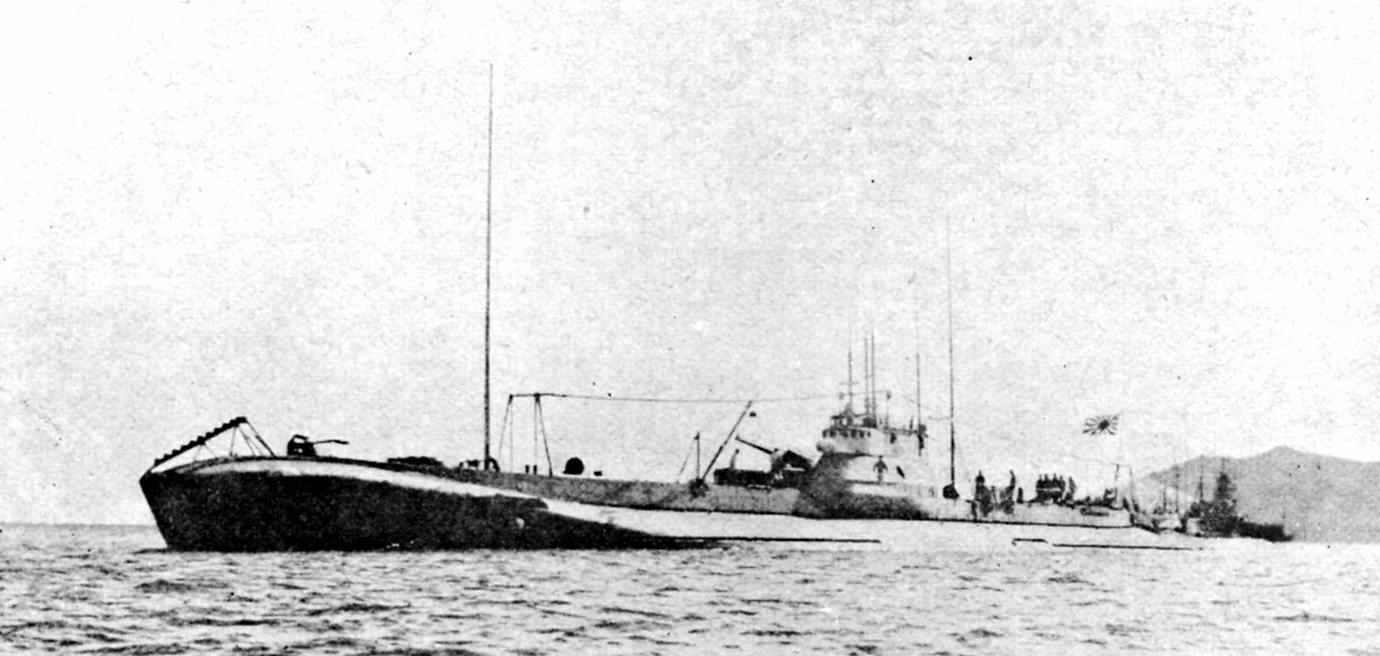 The (''I-153''-class) submarines were similar to the Type KD1 and KD2 but with strengthened hulls. In 1945, ''I-155'' and ''I-158'' were modified as ''Kaiten'' suicide torpedo carriers, each armed with two ''kaitens''.
* /''I-153'' – sank ''Ben 2'' on 20 February in the Indian Ocean, in the Bali Strait on 27 February 1942 and off Java on 28 February 1942. ''I-153'' herself was sunk as a target in the Seto Island Sea in 8 May 1946 as part of Operation Bottom.
* /''I-154'' – scuttled in the Seto Island Sea in May 1946.
* /''I-155'' – sank off Java on 7 February 1942 and in the Java Sea on February 13, 1942. ''I-155'' herself surrendered 2 September 1945 and was scuttled in the Seto Island Sea in May 1946.
* ''I-58''/ – sank in the Java Sea on 3 January 1942, off Bawean Island on 9 January 1942, between Tjilatjap and Padang on 22 February 1942 and south of the Sunda Strait on 25 February 1942. ''I-158'' herself surrendered on 2 September 1945 and was scuttled off the Gotō Islands on 1 April 1946.
The (''I-153''-class) submarines were similar to the Type KD1 and KD2 but with strengthened hulls. In 1945, ''I-155'' and ''I-158'' were modified as ''Kaiten'' suicide torpedo carriers, each armed with two ''kaitens''.
* /''I-153'' – sank ''Ben 2'' on 20 February in the Indian Ocean, in the Bali Strait on 27 February 1942 and off Java on 28 February 1942. ''I-153'' herself was sunk as a target in the Seto Island Sea in 8 May 1946 as part of Operation Bottom.
* /''I-154'' – scuttled in the Seto Island Sea in May 1946.
* /''I-155'' – sank off Java on 7 February 1942 and in the Java Sea on February 13, 1942. ''I-155'' herself surrendered 2 September 1945 and was scuttled in the Seto Island Sea in May 1946.
* ''I-58''/ – sank in the Java Sea on 3 January 1942, off Bawean Island on 9 January 1942, between Tjilatjap and Padang on 22 February 1942 and south of the Sunda Strait on 25 February 1942. ''I-158'' herself surrendered on 2 September 1945 and was scuttled off the Gotō Islands on 1 April 1946.
Type KD3b (3 units)
 The (''I-156''-class) submarines were similar to the Type KD3a but were 16 inches longer and had a different bow shape.
* ''I-56''/ – sank five merchant ships. ''I-156'' surrendered on 2 September 1945 and was scuttled off the Gotō Islands on 1 April 1946 by as part of Operation Road's End.
* ''I-57''/ – sank SS ''Djirak'' on 7 January 1942. ''I-157'' surrendered on 2 September 1945 and scuttled off the Gotō Islands on 1 April 1946 by as part of Operation Road's End.
* ''I-59''/ – sank off Sumatra on March 1, 1942. ''I-159'' surrendered on September 2, 1945, and sunk as a target off the Gotō Islands on 1 April 1946.
* – Accidentally rammed ''I-63'' off Mizunoko Light on 2 February 1939. ''I-60'' herself was sunk off Kratakoa Island on 17 January 1942 by .
* – Accidentally rammed by ''I-60'' off Mizunoko Light on 2 February 1939. Refloated January 1940 and then scrapped.
The (''I-156''-class) submarines were similar to the Type KD3a but were 16 inches longer and had a different bow shape.
* ''I-56''/ – sank five merchant ships. ''I-156'' surrendered on 2 September 1945 and was scuttled off the Gotō Islands on 1 April 1946 by as part of Operation Road's End.
* ''I-57''/ – sank SS ''Djirak'' on 7 January 1942. ''I-157'' surrendered on 2 September 1945 and scuttled off the Gotō Islands on 1 April 1946 by as part of Operation Road's End.
* ''I-59''/ – sank off Sumatra on March 1, 1942. ''I-159'' surrendered on September 2, 1945, and sunk as a target off the Gotō Islands on 1 April 1946.
* – Accidentally rammed ''I-63'' off Mizunoko Light on 2 February 1939. ''I-60'' herself was sunk off Kratakoa Island on 17 January 1942 by .
* – Accidentally rammed by ''I-60'' off Mizunoko Light on 2 February 1939. Refloated January 1940 and then scrapped.
Type KD4 (3 units)
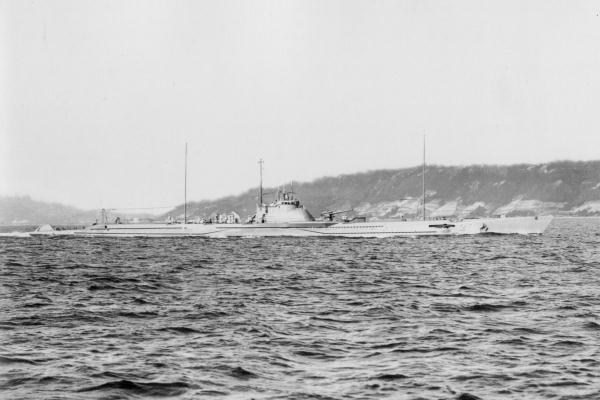 The (''I-61''/''I-162''-class) submarines were slightly smaller and had four torpedo tubes, but were otherwise similar to the Type KD3.
* – Sunk in collision with gunboat in Koshiki Channel on 2 October 1941. Refloated in early 1942 and sold for scrap.
* ''I-62''/ – Sank ''Mikoyan'' on 3 October 1942, ''Manon'' on 7 October 1942 and ''Fort McCloud'' on 22 February 1944. The ''I-162'' herself surrendered on 2 September 1945 and scuttled off the Gotō Islands on 1 April 1946 by as part of Operation Road's End.
* /''I-164'' – Sunk off Cape Ashizuri on 17 May 1942 by .
The (''I-61''/''I-162''-class) submarines were slightly smaller and had four torpedo tubes, but were otherwise similar to the Type KD3.
* – Sunk in collision with gunboat in Koshiki Channel on 2 October 1941. Refloated in early 1942 and sold for scrap.
* ''I-62''/ – Sank ''Mikoyan'' on 3 October 1942, ''Manon'' on 7 October 1942 and ''Fort McCloud'' on 22 February 1944. The ''I-162'' herself surrendered on 2 September 1945 and scuttled off the Gotō Islands on 1 April 1946 by as part of Operation Road's End.
* /''I-164'' – Sunk off Cape Ashizuri on 17 May 1942 by .
Type KD5 (3 units)
 The (''I-165''-class) submarines were similar to the Type KD4 but had an improved operating depth.
* ''I-65''/ – Depth-charged off Saipan on 27 June 1945 by a US Navy patrol bomber of VPB-142.
* ''I-66''/ – Sunk off One Fathom Bank on 17 July 1944 by .
* – Sank in diving accident off Minamitorishima on 29 August 1940.
The (''I-165''-class) submarines were similar to the Type KD4 but had an improved operating depth.
* ''I-65''/ – Depth-charged off Saipan on 27 June 1945 by a US Navy patrol bomber of VPB-142.
* ''I-66''/ – Sunk off One Fathom Bank on 17 July 1944 by .
* – Sank in diving accident off Minamitorishima on 29 August 1940.
Type KD6a (6 units)
 The (''I-168''-class) submarines were similar to the KD5 but with a higher speed.
* ''I-68''/ – Sunk in the Steffen Strait on 27 July 1943 by .
* ''I-69''/ – Sank in diving accident in Truk Lagoon on 4 April 1944.
* – Sunk by a Douglas SBD Dauntless aircraft from VS-6 () on 10 December 1941. This was the first enemy combatant ship sunk by U.S. forces.
* ''I-71''/ – Depth-charged off Buka Island on 1 February 1944 by and .
* /''I-172'' – Missing after 28 October 1942. Possibly depth-charged off San Cristóbal by on 3 November 1942.
* – Sunk by on 27 January 1942. ''I-73'' was the first warship sunk by a US Navy submarine.
The (''I-168''-class) submarines were similar to the KD5 but with a higher speed.
* ''I-68''/ – Sunk in the Steffen Strait on 27 July 1943 by .
* ''I-69''/ – Sank in diving accident in Truk Lagoon on 4 April 1944.
* – Sunk by a Douglas SBD Dauntless aircraft from VS-6 () on 10 December 1941. This was the first enemy combatant ship sunk by U.S. forces.
* ''I-71''/ – Depth-charged off Buka Island on 1 February 1944 by and .
* /''I-172'' – Missing after 28 October 1942. Possibly depth-charged off San Cristóbal by on 3 November 1942.
* – Sunk by on 27 January 1942. ''I-73'' was the first warship sunk by a US Navy submarine.
Type KD6b (2 units)
 The (''I-174''-class) submarines were similar to the KD6a but were one foot longer and 25 tons heavier.
* – sunk off Chuuk Lagoon, Truk on 12 April 1944 by aircraft from VB-108.
* – sunk off Wotje Atoll on 17 February 1944 by .
The (''I-174''-class) submarines were similar to the KD6a but were one foot longer and 25 tons heavier.
* – sunk off Chuuk Lagoon, Truk on 12 April 1944 by aircraft from VB-108.
* – sunk off Wotje Atoll on 17 February 1944 by .
Type KD7 (10 units)
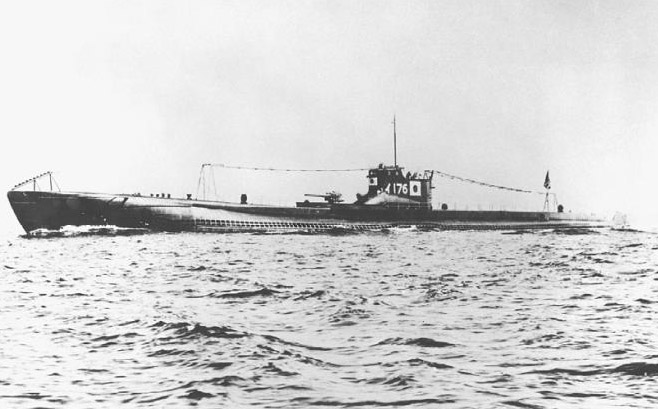 The or (''I-176''-class) submarines were similar to the KD6 but with the torpedo tubes moved forward and a slightly improved operating depth.
* ''I-76''/ – sank patrolling off Truk on 16 November 1943, the only known Japanese submarine success against a US submarine – was a probable second victim by Japanese submarines. ''I-176'' was lost a year later off Buka Island on 16 May 1944, depth-charged by , , and .
* – Sank off Australia on 14 May 1943. The ''I-177'' herself is sunk by on 3 October 1944.
* ''I-78''/ – Missing after 17 June 1943. Possibly sunk 25 August 1943 near the Solomon Islands by .
* ''I-79''/ – Sank during sea trials in the Seto Island Sea on 14 July 1943. Salvaged 1956-1957 and then scrapped.
* ''I-80''/ – Sunk off Chirikof Island on 27 April 1944 by .
* ''I-81''/ – Ran aground and sunk in Kelanoa Harbour on 16 January 1944.
* ''I-82''/ – Sunk off the New Hebrides on 1 September 1943 by .
* ''I-83''/ – Sunk near the Bondo Strait on 29 April 1944 by .
* ''I-84''/ – Sunk near Saipan on 19 June 1944 by a torpedo bomber from .
* ''I-85''/ – Sunk near Saipan on 22 June 1944 by .
The or (''I-176''-class) submarines were similar to the KD6 but with the torpedo tubes moved forward and a slightly improved operating depth.
* ''I-76''/ – sank patrolling off Truk on 16 November 1943, the only known Japanese submarine success against a US submarine – was a probable second victim by Japanese submarines. ''I-176'' was lost a year later off Buka Island on 16 May 1944, depth-charged by , , and .
* – Sank off Australia on 14 May 1943. The ''I-177'' herself is sunk by on 3 October 1944.
* ''I-78''/ – Missing after 17 June 1943. Possibly sunk 25 August 1943 near the Solomon Islands by .
* ''I-79''/ – Sank during sea trials in the Seto Island Sea on 14 July 1943. Salvaged 1956-1957 and then scrapped.
* ''I-80''/ – Sunk off Chirikof Island on 27 April 1944 by .
* ''I-81''/ – Ran aground and sunk in Kelanoa Harbour on 16 January 1944.
* ''I-82''/ – Sunk off the New Hebrides on 1 September 1943 by .
* ''I-83''/ – Sunk near the Bondo Strait on 29 April 1944 by .
* ''I-84''/ – Sunk near Saipan on 19 June 1944 by a torpedo bomber from .
* ''I-85''/ – Sunk near Saipan on 22 June 1944 by .
Type J1 (''I-1'', ''I-2'', ''I-3'', ''I-4'')
 The (''I-1''-class) submarines were based on the Kaidai II (Type KD2) and German submarine .
* – sank off Western Australia on March 3, 1942. ''I-1'' herself was attacked by and ran aground on Fish Reef January 29, 1943; valuable codes and code books from the wreck are salvaged by Allied forces.
* – sank HMS ''Nam Yong'' off Christmas Island on February 28, 1942, and in the Indian Ocean on March 1, 1942. ''I-2'' herself was sunk in the Bismarck Sea on April 7, 1944, by .
* – sunk December 9, 1942 near Kamimbo Bay by ''Motor Torpedo Boat PT-59, PT-59''.
* – sank off Oahu December 14, 1941, off Bali February 28, 1942 and USS ''Washingtonian'' off Eight Degree Channel April 6, 1942. ''I-4'' herself was sunk in St. George's Channel on December 21, 1942, by .
The (''I-1''-class) submarines were based on the Kaidai II (Type KD2) and German submarine .
* – sank off Western Australia on March 3, 1942. ''I-1'' herself was attacked by and ran aground on Fish Reef January 29, 1943; valuable codes and code books from the wreck are salvaged by Allied forces.
* – sank HMS ''Nam Yong'' off Christmas Island on February 28, 1942, and in the Indian Ocean on March 1, 1942. ''I-2'' herself was sunk in the Bismarck Sea on April 7, 1944, by .
* – sunk December 9, 1942 near Kamimbo Bay by ''Motor Torpedo Boat PT-59, PT-59''.
* – sank off Oahu December 14, 1941, off Bali February 28, 1942 and USS ''Washingtonian'' off Eight Degree Channel April 6, 1942. ''I-4'' herself was sunk in St. George's Channel on December 21, 1942, by .
Type J1 Mod. (''I-5'')
 The (''I-5''-class) submarine was similar to the Type J1, but with facilities for one aircraft.
* – possibly sunk 19 July 1944 off Guam by .
The (''I-5''-class) submarine was similar to the Type J1, but with facilities for one aircraft.
* – possibly sunk 19 July 1944 off Guam by .
Type J2 (''I-6'')
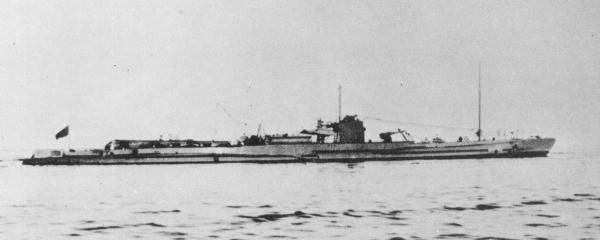 The (''I-6''-class) submarine was similar to the ''I-5'' class, but with a catapult for aircraft.
* – sank ''Clan Ross'' in the Arabian Sea on April 2, 1942, and ''Bahadur'' in the Arabian Sea on April 7, 1942. ''I-6'' herself was accidentally rammed and sunk 16 June 1944 off Hachijō-jima by ''Toyokawa Maru''.
The (''I-6''-class) submarine was similar to the ''I-5'' class, but with a catapult for aircraft.
* – sank ''Clan Ross'' in the Arabian Sea on April 2, 1942, and ''Bahadur'' in the Arabian Sea on April 7, 1942. ''I-6'' herself was accidentally rammed and sunk 16 June 1944 off Hachijō-jima by ''Toyokawa Maru''.
Type J3 (''I-7'', ''I-8'')
 The (''I-7''-class) submarines combined the benefits of the Type J2 and the Kaidai V (KD5). This type later led to the Type A, Type B, and Type C submarines.
* – sank ''Merkus'' off Cocos Island on March 4, 1942, ''Glenshiel'' in the Indian Ocean on April 3, 1942, and USS ''Arcata'' off Unalaska on July 14, 1942. ''I-7'' herself was damaged by gunfire off Kiska June 22, 1943 from and ran aground on the Twin Rocks. ''I-7'' was scuttled on June 23.
* – sank ''Tjisalak'' on March 26, 1944, in the Indian Ocean and ''Jean Nicolet'' in May 1944. ''I-8'' herself is sunk off Okinawa on March 31, 1945, by .
The (''I-7''-class) submarines combined the benefits of the Type J2 and the Kaidai V (KD5). This type later led to the Type A, Type B, and Type C submarines.
* – sank ''Merkus'' off Cocos Island on March 4, 1942, ''Glenshiel'' in the Indian Ocean on April 3, 1942, and USS ''Arcata'' off Unalaska on July 14, 1942. ''I-7'' herself was damaged by gunfire off Kiska June 22, 1943 from and ran aground on the Twin Rocks. ''I-7'' was scuttled on June 23.
* – sank ''Tjisalak'' on March 26, 1944, in the Indian Ocean and ''Jean Nicolet'' in May 1944. ''I-8'' herself is sunk off Okinawa on March 31, 1945, by .
Type A1 (''I-9'', ''I-10'', ''I-11'')
 The (''I-9''-class) submarines were large seaplane-carrying submarines, with communication facilities to allow them to operate as command ships for groups of submarines. The type was also equipped with a hangar for one aircraft.
* – sunk June 14, 1943 off Kiska by .
* – sunk July 4, 1944 off Saipan by and .
* – sunk February 17, 1944 by .
The (''I-9''-class) submarines were large seaplane-carrying submarines, with communication facilities to allow them to operate as command ships for groups of submarines. The type was also equipped with a hangar for one aircraft.
* – sunk June 14, 1943 off Kiska by .
* – sunk July 4, 1944 off Saipan by and .
* – sunk February 17, 1944 by .
Type AM1/A2 (''I-12'')
The (''I-12''-class) submarine was similar to the Type A1, but with less powerful engines, giving the type slower surface speed but a longer range. * – sunk November 13, 1944 by and .Type AM2/AM (''I-13'', ''I-14'')
The (Type AM (A Modified), ''I-13''-class) submarines was a large seaplane-carrying submarine, with hangar space for two aircraft. These giant submarines were originally of the A2 type, but following the cancellation of a number of ''I-400''-class submarines, their design was revised after construction started to carry a second aircraft. The seaplanes were to be the Aichi M6A1 bomber carrying 800 kg bombs. The range and speed of these submarines was remarkable, at , but their underwater performance was compromised, making them easy targets. * — Sunk 16 July 1945 by and aircraft from about east of Yokosuka. * – Surrendered 27 August 1945. Sunk as target 28 May 1946 off Oahu, Hawaii, in of water by . Wreck found in 2009.Type B1 (20 units)
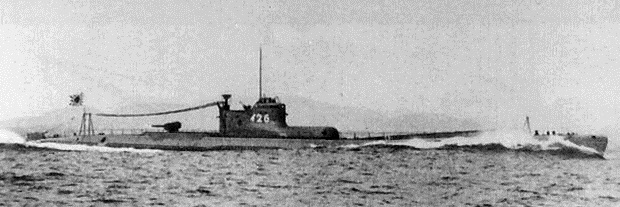 The (''I-15''-class) submarines were the most numerous type of submarines of the Imperial Japanese Navy during World War II. In total 20 were made, starting with ''I-15'', the class ship. These were fast, very long ranged, and carried a single Yokosuka E14Y seaplane, located in a hangar in front of the conning tower, launched by a catapult.
The series was rather successful, especially at the beginning of the war. , in 1942, crippled the aircraft carrier . , on 15 September 1942, fired six torpedoes at aircraft carrier , two of which hit the carrier and sank her, the remainder damaging the battleship and the destroyer (which sank later); conducted the only aerial bombing to occur on the continental United States during World War II. On 9 September 1942, ''I-25'' launched its reconnaissance plane, a Yokosuka E14Y code named ''Glen'' which proceeded to drop four 168 pound bombs in a forest near present-day Brookings, Oregon, Brookings, Oregon. Several of these ships also undertook "Yanagi" missions to Europe (, , ).
* – Sunk 10 November 1942 by .
* – Sunk 19 August 1943 by and US Navy Kingfisher aircraft.
* – Sank USS Wasp and USS ''O'Brien'' on 15 September 1942 and on 16 May 1943. The ''I-16'' herself was depth-charged on 25 November 1943 by .
* – Sank on 23 December 1941, possibly sank USS Porter on 26 October 1942, on 17 January 1943, on 8 February 1943, ''Mobilube'' on 18 January 1943, ''Starr King'' on 11 February 1943 and ''Cape San Juan'' on 12 November 1943. The ''I-21'' herself was missing after 27 November 1943. Possibly sunk off Tarawa by TBF Avengers on 29 November 1943.
* – Missing off Oahu after 24 February 1942.
* – Sunk 3 September 1943 off the New Hebrides by one or more US destroyers.
* – Sunk 26 October 1944 off Leyte by or .
* – Sunk 12 February 1944 by and .
* – Sunk 6 February 1942 by .
* – Sunk 26 July 1944 by
* – Sunk by a mine near Singapore on 8 October 1942. Salvaged between August 1959 and February 1960 and then scrapped.
* – Sunk 13 May 1943 by .
* – Missing after 23 March 1944. Possibly sunk on 24 March 1944 by .
* – Sank at Truk 26 September 1942. Refloated 29 December 1942. Sank again 13 June 1944 in the Seto Inland Sea during trials. Salvaged between 23 July and 18 August 1953 and then scrapped.
* – Sunk in the Malacca Straits by . Salvaged in 1962.
* – Rammed and sunk 23 November 1943 by .
* – Scuttled off the Gotō Islands on 1 April 1946 along with ''Ha-106'' as part of Operation Road's End.
* – Sunk 19 November 1944 off Palau by and .
* – Missing after 7 November 1944. Possibly depth-charged on 13 November 1944 by .
* – Missing after 25 November 1943. Possibly sunk on 26 November 1943 by .
The (''I-15''-class) submarines were the most numerous type of submarines of the Imperial Japanese Navy during World War II. In total 20 were made, starting with ''I-15'', the class ship. These were fast, very long ranged, and carried a single Yokosuka E14Y seaplane, located in a hangar in front of the conning tower, launched by a catapult.
The series was rather successful, especially at the beginning of the war. , in 1942, crippled the aircraft carrier . , on 15 September 1942, fired six torpedoes at aircraft carrier , two of which hit the carrier and sank her, the remainder damaging the battleship and the destroyer (which sank later); conducted the only aerial bombing to occur on the continental United States during World War II. On 9 September 1942, ''I-25'' launched its reconnaissance plane, a Yokosuka E14Y code named ''Glen'' which proceeded to drop four 168 pound bombs in a forest near present-day Brookings, Oregon, Brookings, Oregon. Several of these ships also undertook "Yanagi" missions to Europe (, , ).
* – Sunk 10 November 1942 by .
* – Sunk 19 August 1943 by and US Navy Kingfisher aircraft.
* – Sank USS Wasp and USS ''O'Brien'' on 15 September 1942 and on 16 May 1943. The ''I-16'' herself was depth-charged on 25 November 1943 by .
* – Sank on 23 December 1941, possibly sank USS Porter on 26 October 1942, on 17 January 1943, on 8 February 1943, ''Mobilube'' on 18 January 1943, ''Starr King'' on 11 February 1943 and ''Cape San Juan'' on 12 November 1943. The ''I-21'' herself was missing after 27 November 1943. Possibly sunk off Tarawa by TBF Avengers on 29 November 1943.
* – Missing off Oahu after 24 February 1942.
* – Sunk 3 September 1943 off the New Hebrides by one or more US destroyers.
* – Sunk 26 October 1944 off Leyte by or .
* – Sunk 12 February 1944 by and .
* – Sunk 6 February 1942 by .
* – Sunk 26 July 1944 by
* – Sunk by a mine near Singapore on 8 October 1942. Salvaged between August 1959 and February 1960 and then scrapped.
* – Sunk 13 May 1943 by .
* – Missing after 23 March 1944. Possibly sunk on 24 March 1944 by .
* – Sank at Truk 26 September 1942. Refloated 29 December 1942. Sank again 13 June 1944 in the Seto Inland Sea during trials. Salvaged between 23 July and 18 August 1953 and then scrapped.
* – Sunk in the Malacca Straits by . Salvaged in 1962.
* – Rammed and sunk 23 November 1943 by .
* – Scuttled off the Gotō Islands on 1 April 1946 along with ''Ha-106'' as part of Operation Road's End.
* – Sunk 19 November 1944 off Palau by and .
* – Missing after 7 November 1944. Possibly depth-charged on 13 November 1944 by .
* – Missing after 25 November 1943. Possibly sunk on 26 November 1943 by .
Type B2 (6 units)
 The (''I-40''-class) submarines were externally similar to the Type B1, but with a high-tensile strength steel hull and diesel engines of a simpler design. In 1944, ''I-44'' was modified as a ''Kaiten'' suicide torpedo carrier, armed with six ''kaitens''.
* – Missing off the Gilbert Islands after 22 November 1943.
* – Sunk 18 November 1944 by .
* – Sunk 23 March 1944 by .
* – Sunk 15 February 1944 by .
* – Missing off Okinawa after 4 April 1945. Possibly sunk off Okinawa by a TBM Avenger of VC-92 on 29 April 1945.
* – Sunk 29 October 1944 by .
The (''I-40''-class) submarines were externally similar to the Type B1, but with a high-tensile strength steel hull and diesel engines of a simpler design. In 1944, ''I-44'' was modified as a ''Kaiten'' suicide torpedo carrier, armed with six ''kaitens''.
* – Missing off the Gilbert Islands after 22 November 1943.
* – Sunk 18 November 1944 by .
* – Sunk 23 March 1944 by .
* – Sunk 15 February 1944 by .
* – Missing off Okinawa after 4 April 1945. Possibly sunk off Okinawa by a TBM Avenger of VC-92 on 29 April 1945.
* – Sunk 29 October 1944 by .
Type B3 (''I-54'', ''I-56'', ''I-58'')
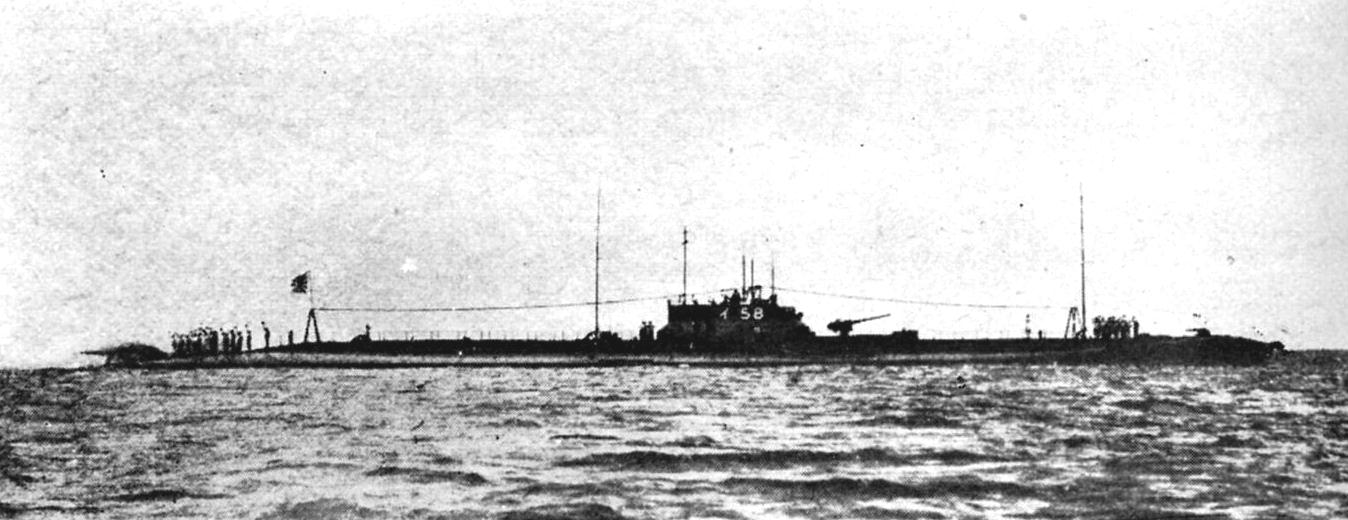 Eighteen of the twenty-one (''I-54''-class) submarines were cancelled in 1943 in favor of the Type E submarine, leaving the ''I-54'', ''I-56'', and ''I-58''. In 1944, ''I-56'' and ''I-58'' were modified as ''Kaiten'' suicide torpedo carriers, each armed with four ''kaitens''.
* – Missing off Leyte after 23 October 1944. Possibly sunk 28 October 1944 by and .
* – Possibly sank sometime after 8 April 1945. ''I-56'' was herself later sunk 18 April 1945 by .
* – Sank on 30 July 1945. ''I-58'' surrendered on 2 September 1945, and scuttled off the Gotō Islands on 1 April 1946 as part of Operation Road's End. The wreckage of ''I-58'' was found in 2017.
Eighteen of the twenty-one (''I-54''-class) submarines were cancelled in 1943 in favor of the Type E submarine, leaving the ''I-54'', ''I-56'', and ''I-58''. In 1944, ''I-56'' and ''I-58'' were modified as ''Kaiten'' suicide torpedo carriers, each armed with four ''kaitens''.
* – Missing off Leyte after 23 October 1944. Possibly sunk 28 October 1944 by and .
* – Possibly sank sometime after 8 April 1945. ''I-56'' was herself later sunk 18 April 1945 by .
* – Sank on 30 July 1945. ''I-58'' surrendered on 2 September 1945, and scuttled off the Gotō Islands on 1 April 1946 as part of Operation Road's End. The wreckage of ''I-58'' was found in 2017.
Type C1 (5 units)
 The (''I-16''-class) submarines were based on the Junsen type submarine and developed from the Type KD6. This type, like the other Type C submarines, was utilized as mother ships for the Type A Kō-hyōteki-class submarine, ''Kō-hyōteki'' midget submarines and the ''Kaiten'' suicide torpedoes.
* – Sank ''Susak'' on 6 June 1942, ''Aghious Georgios'' on 8 June 1942, ''Supetar'' on 12 June 1942, and ''Eknaren'' on 1 July 1942. Sunk 19 May 1944 by .
* – Sank ''Wilford'' on 8 June 1942, ''Mundra'' on 2 July 1942, and ''De Weert'' on 3 July 1942. Sunk 11 February 1943 by .
* – Sank ''Johnstown'' on 5 June 1942, ''Christos Markettos'' on 8 June 1942, ''Mahronda'' on 11 June 1942, ''Hellenic Trader'' and ''Clifton Hall'' on 12 June 1942, ''Goviken'' on 29 June 1942, and ''Steaua Romana'' on 30 June 1942. Missing after 31 August 1943, probably sunk either on 1 September 1943 by or on 3 September 1943 by .
* – Sunk 6 October 1942 by U.S. Navy Consolidated PBY Catalina, PBY Catalina.
* – Sank on 3 June 1942. Sunk 11 June 1943 by .
The (''I-16''-class) submarines were based on the Junsen type submarine and developed from the Type KD6. This type, like the other Type C submarines, was utilized as mother ships for the Type A Kō-hyōteki-class submarine, ''Kō-hyōteki'' midget submarines and the ''Kaiten'' suicide torpedoes.
* – Sank ''Susak'' on 6 June 1942, ''Aghious Georgios'' on 8 June 1942, ''Supetar'' on 12 June 1942, and ''Eknaren'' on 1 July 1942. Sunk 19 May 1944 by .
* – Sank ''Wilford'' on 8 June 1942, ''Mundra'' on 2 July 1942, and ''De Weert'' on 3 July 1942. Sunk 11 February 1943 by .
* – Sank ''Johnstown'' on 5 June 1942, ''Christos Markettos'' on 8 June 1942, ''Mahronda'' on 11 June 1942, ''Hellenic Trader'' and ''Clifton Hall'' on 12 June 1942, ''Goviken'' on 29 June 1942, and ''Steaua Romana'' on 30 June 1942. Missing after 31 August 1943, probably sunk either on 1 September 1943 by or on 3 September 1943 by .
* – Sunk 6 October 1942 by U.S. Navy Consolidated PBY Catalina, PBY Catalina.
* – Sank on 3 June 1942. Sunk 11 June 1943 by .
Type C2 (''I-46'', ''I-47'', ''I-48'')
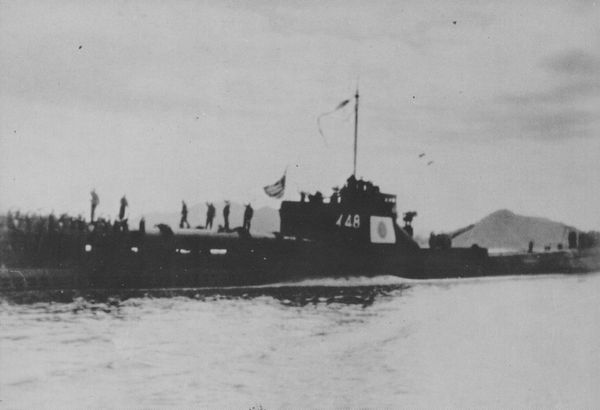 The (''I-46''-subclass) submarines were nearly identical to the Type C1 with the exception that the Type C2 lacked the capability to carry the midget submarines. ''I-47'' and ''I-48'' were converted to carry ''kaiten'' manned suicide attack torpedoes.
* – Missing after 26 October 1944. Possibly sunk by and on 28 October 1944. Also reported sunk by a multi-destroyer gun action involving , , , and around 28 November 1944.
* – Sank on 20 November 1944. ''I-47'' surrendered on 2 September 1945 and was scuttled off the Gotō Islands on 1 April 1946 as part of Operation Road's End. The wreck of ''I-47'' was found in 2017.
* – Sunk January 23, 1945 by .
The (''I-46''-subclass) submarines were nearly identical to the Type C1 with the exception that the Type C2 lacked the capability to carry the midget submarines. ''I-47'' and ''I-48'' were converted to carry ''kaiten'' manned suicide attack torpedoes.
* – Missing after 26 October 1944. Possibly sunk by and on 28 October 1944. Also reported sunk by a multi-destroyer gun action involving , , , and around 28 November 1944.
* – Sank on 20 November 1944. ''I-47'' surrendered on 2 September 1945 and was scuttled off the Gotō Islands on 1 April 1946 as part of Operation Road's End. The wreck of ''I-47'' was found in 2017.
* – Sunk January 23, 1945 by .
Type C3 (''I-52'', ''I-53'', ''I-55'')
The submarines (''I-52''-class) were submarines of the Imperial Japanese Navy, designed and built by Mitsubishi Corporation, between 1943 and 1944, as cargo carriers. They were quite long and carried a crew of up to 94 officers and enlisted. They also had a long cruising range at a speed of . The Japanese constructed only three of these during World War II (, and ), although twenty were planned. They were among the largest submarines ever built to date, and were known as the most advanced submarines of the period. ''I-53'' was converted to carry ''kaiten'' manned suicide attack torpedoes. * – Sunk during Yanagi missions, ''Yanagi'' (exchange) mission to Nazi Germany, Germany on 24 June 1944 by aircraft from southwest of the Azores. She was carrying Japanese engineers and a cargo of rubber, gold, and quinine to Germany. * – Sank on 24 July 1945. ''I-53'' surrendered on 2 September 1945 and sunk as a target off the Gotō Islands on 1 April 1946 by as part of Operation Road's End. The wreck of the ''I-53'' was found in 2017. * – Missing after 13 July 1945. Possibly sunk by on 14 July 1944. Sinking also credited to and on 28 July 1944.Type D1 (11 units)
 The or (''I-361''-class) and (''I-372''-class) submarines were based on the ''German submarine Deutschland, U-155''. This type was designed as transport submarines with torpedoes for self-defense. Five of the submarines — ''I-361'', ''I-363'', ''I-366'', ''I-367'', and ''I-370'' — were later modified to serve as ''kaiten'' suicide attack torpedo carriers, each armed with five ''kaitens''.
* – Sunk southeast of Okinawa on 31 May 1945, by aircraft from .
* – Sunk in eastern Caroline Islands on 14 January 1945, by .
* – Sunk by Naval mine, mine off Miyazaki Prefecture, Miyazaki on 29 October 1945. Salvaged and scrapped on 26 January 1966.
* – Sunk east of Honshu on 16 September 1944, by .
* – Sunk southeast of Yokosuka on 29 November 1944, by .
* – Blown up and scuttled off the Gotō Islands on 1 April 1946 as part of Operation Road's End.
* – Blown up and scuttled off the Gotō Islands on 1 April 1946 as part of Operation Road's End.
* – Sunk west of Iwo Jima on 26 February 1945, by aircraft from .
* – Scrapped 1946.
* – Sunk near Iwo Jima on 26 February 1945, by .
* – Sunk in Bungo Strait on 24 February 1945, by .
* – Sunk at Yokosuka on 18 July 1945, by aircraft from Task Force 38.
The or (''I-361''-class) and (''I-372''-class) submarines were based on the ''German submarine Deutschland, U-155''. This type was designed as transport submarines with torpedoes for self-defense. Five of the submarines — ''I-361'', ''I-363'', ''I-366'', ''I-367'', and ''I-370'' — were later modified to serve as ''kaiten'' suicide attack torpedo carriers, each armed with five ''kaitens''.
* – Sunk southeast of Okinawa on 31 May 1945, by aircraft from .
* – Sunk in eastern Caroline Islands on 14 January 1945, by .
* – Sunk by Naval mine, mine off Miyazaki Prefecture, Miyazaki on 29 October 1945. Salvaged and scrapped on 26 January 1966.
* – Sunk east of Honshu on 16 September 1944, by .
* – Sunk southeast of Yokosuka on 29 November 1944, by .
* – Blown up and scuttled off the Gotō Islands on 1 April 1946 as part of Operation Road's End.
* – Blown up and scuttled off the Gotō Islands on 1 April 1946 as part of Operation Road's End.
* – Sunk west of Iwo Jima on 26 February 1945, by aircraft from .
* – Scrapped 1946.
* – Sunk near Iwo Jima on 26 February 1945, by .
* – Sunk in Bungo Strait on 24 February 1945, by .
* – Sunk at Yokosuka on 18 July 1945, by aircraft from Task Force 38.
Type D2 (''I-373'')
The (''I-373''-class) submarine was designed as a tanker submarine based on the Type D1 but with no torpedoes. * – sunk in the East China Sea on August 14, 1945, by . ''I-373'' was the last Japanese submarine sunk in World War II.''Kiraisen'' Type (4 units)
 The (''I-121''-class), the only Japanese minelayer submarines, were near-copies of the World War I German minelayer submarine ''SM UB-125, UB-125''. Originally numbered ''I-21'', ''I-22'', ''I-23'', and ''I-24'', they were renumbered ''I-121'', ''I-122'', ''I-123'', and ''I-124'', respectively, in 1938. This type saw front-line service during the Second Sino-Japanese War and the first half of World War II, modified to add seaplane refueling to their capabilities, but surviving units were relegated to training duties in September 1943 due to their growing obsolescence.
* ''I-21''/ – Surrendered in September 1945 and scuttled in Wakasa Bay along with ''Ro-68'' and ''Ro-500'' on 30 April 1946.
* ''I-22''/ – Sunk in the Sea of Japan 9 June 1945 by .
* ''I-23''/ – Sunk off Savo Island 29 August 1942 by .
* ''I-24''/ – Sank ''Hareldawns'' off Luzon on 10 December 1941. Sunk off Darwin 20 January 1942 by . ''I-124'' was the first IJN warship sunk by the Royal Australian Navy.
The (''I-121''-class), the only Japanese minelayer submarines, were near-copies of the World War I German minelayer submarine ''SM UB-125, UB-125''. Originally numbered ''I-21'', ''I-22'', ''I-23'', and ''I-24'', they were renumbered ''I-121'', ''I-122'', ''I-123'', and ''I-124'', respectively, in 1938. This type saw front-line service during the Second Sino-Japanese War and the first half of World War II, modified to add seaplane refueling to their capabilities, but surviving units were relegated to training duties in September 1943 due to their growing obsolescence.
* ''I-21''/ – Surrendered in September 1945 and scuttled in Wakasa Bay along with ''Ro-68'' and ''Ro-500'' on 30 April 1946.
* ''I-22''/ – Sunk in the Sea of Japan 9 June 1945 by .
* ''I-23''/ – Sunk off Savo Island 29 August 1942 by .
* ''I-24''/ – Sank ''Hareldawns'' off Luzon on 10 December 1941. Sunk off Darwin 20 January 1942 by . ''I-124'' was the first IJN warship sunk by the Royal Australian Navy.
''Sen-Ho'' Type (''I-351'')
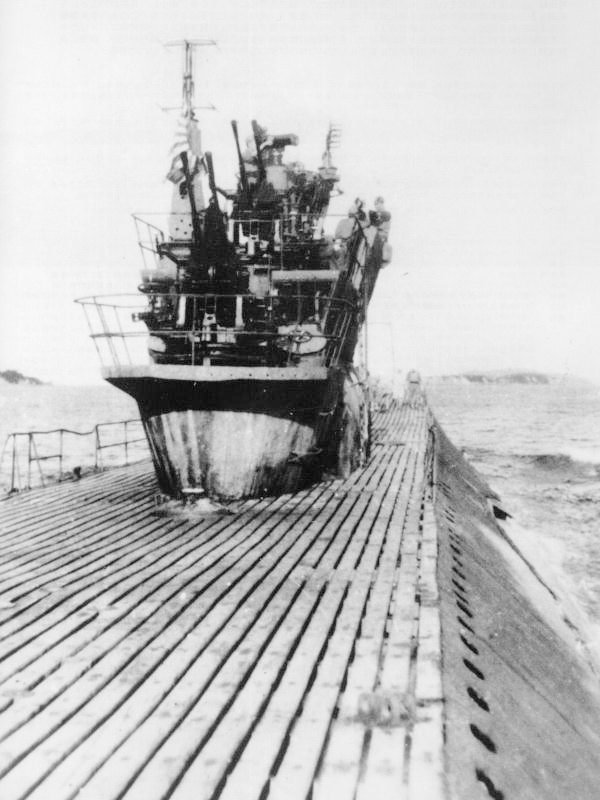 The (''I-351''-class) was a tanker/transport submarine.
* – sunk July 14, 1945 in the South China Sea by .
The (''I-351''-class) was a tanker/transport submarine.
* – sunk July 14, 1945 in the South China Sea by .
''Sentoku'' Type (''I-400'', ''I-401'', ''I-402'')
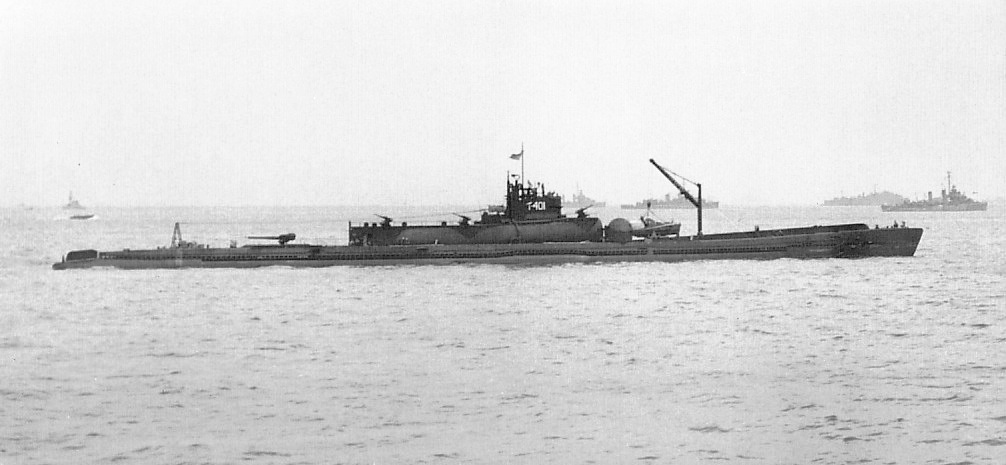 The (''I-400''-class) displaced 5,223 tons surfaced and measured overall. They had a figure-eight hull shape for additional strength to handle the on-deck hangar for housing the three Aichi M6A, ''Seiran'' aircraft. In addition, they had four anti-aircraft guns, a large deck gun as well as eight torpedo tubes from which they could fire the Type 95 torpedo.
Three of the ''Sentoku'' were built (, , and ). Each had four Fitzsimons, Bernard, ed. "''I-400''", ''Encyclopedia of Twentieth Century Weapons and Warfare'' (London: Phoebux, 1978), Volume 13, p.1415. engines and range at .
The submarines were also able to carry three Aichi M6A ''Sei ran'' aircraft, each carrying an bomb at . To fit the aircraft in the hangar the wings of the aircraft were folded back, the horizontal stabilizers folded down, and the top of the vertical stabilizer folded over so the overall profile of the aircraft was within the diameter of its propeller. A crew of four could prepare and get all three airborne in 45 minutes launching them with a 120-foot (37 m) catapult on the fore deck of the giant submarine.
* ''I-400'' – sunk as a target off Pearl Harbor on June 4, 1946, by . The wreck was found in 2013.
* ''I-401'' – sunk as a target off Pearl Harbor on May 31, 1946, by . The wreck was found in 2005.
* ''I-402'' – scuttled with off Kinai Island on 1 April 1946. The wreck was found in 2015.
The (''I-400''-class) displaced 5,223 tons surfaced and measured overall. They had a figure-eight hull shape for additional strength to handle the on-deck hangar for housing the three Aichi M6A, ''Seiran'' aircraft. In addition, they had four anti-aircraft guns, a large deck gun as well as eight torpedo tubes from which they could fire the Type 95 torpedo.
Three of the ''Sentoku'' were built (, , and ). Each had four Fitzsimons, Bernard, ed. "''I-400''", ''Encyclopedia of Twentieth Century Weapons and Warfare'' (London: Phoebux, 1978), Volume 13, p.1415. engines and range at .
The submarines were also able to carry three Aichi M6A ''Sei ran'' aircraft, each carrying an bomb at . To fit the aircraft in the hangar the wings of the aircraft were folded back, the horizontal stabilizers folded down, and the top of the vertical stabilizer folded over so the overall profile of the aircraft was within the diameter of its propeller. A crew of four could prepare and get all three airborne in 45 minutes launching them with a 120-foot (37 m) catapult on the fore deck of the giant submarine.
* ''I-400'' – sunk as a target off Pearl Harbor on June 4, 1946, by . The wreck was found in 2013.
* ''I-401'' – sunk as a target off Pearl Harbor on May 31, 1946, by . The wreck was found in 2005.
* ''I-402'' – scuttled with off Kinai Island on 1 April 1946. The wreck was found in 2015.
''Sentaka'' Type (3 units)
 The (''I-201'-class) submarines were modern design, and known as ''Sentaka'' (From ''Sen'', abbreviation of ''Sensuikan'', "Submarine", and ''Taka'', abbreviation of ''Kōsoku'', "High speed"). Three were built, ''I-201'', ''I-202'', and ''I-203'' (''I-204'' to ''I-208'' were not completed).
They displaced 1,070 tonnes, had a test depth of , and were armed with four torpedo tubes and Type 96 25 mm AT/AA Gun, Type 96 guns in retractable mounts to maintain streamlining. These submarines were designed for mass production. They were high-performance boats, with streamlined all-welded hulls and a high battery capacity supplying two motors, which had nearly double the horsepower of the German-designed MAN SE, MAN diesels. The submerged speed was , more than double that achieved by contemporary American designs. They were equipped with a snorkel, allowing for underwater diesel operation while recharging batteries.
* – sunk as a target off Pearl Harbor on May 23, 1946 by . The wreck of ''I-201'' was found in 2009 along with that of .
* – scuttled by the US Navy off the Gotō Islands on 5 April 1946 to avoid trouble between Britain and the Soviet Union (as both nations wanted to acquire the submarine).
* – sunk as a target off Pearl Harbor on 21 May 1946 by .
The (''I-201'-class) submarines were modern design, and known as ''Sentaka'' (From ''Sen'', abbreviation of ''Sensuikan'', "Submarine", and ''Taka'', abbreviation of ''Kōsoku'', "High speed"). Three were built, ''I-201'', ''I-202'', and ''I-203'' (''I-204'' to ''I-208'' were not completed).
They displaced 1,070 tonnes, had a test depth of , and were armed with four torpedo tubes and Type 96 25 mm AT/AA Gun, Type 96 guns in retractable mounts to maintain streamlining. These submarines were designed for mass production. They were high-performance boats, with streamlined all-welded hulls and a high battery capacity supplying two motors, which had nearly double the horsepower of the German-designed MAN SE, MAN diesels. The submerged speed was , more than double that achieved by contemporary American designs. They were equipped with a snorkel, allowing for underwater diesel operation while recharging batteries.
* – sunk as a target off Pearl Harbor on May 23, 1946 by . The wreck of ''I-201'' was found in 2009 along with that of .
* – scuttled by the US Navy off the Gotō Islands on 5 April 1946 to avoid trouble between Britain and the Soviet Union (as both nations wanted to acquire the submarine).
* – sunk as a target off Pearl Harbor on 21 May 1946 by .
Second-class submarines
These submarines included medium-sized, medium-ranged units of the Imperial Japanese Navy.Type F1 (''Ro-1'', ''Ro-2'')
 Constructed between 1917 and 1920, (''Ro-1''-class) submarines were the first truly oceangoing Japanese submarines and the earliest to be rated as "second-class" or "medium" submarines. The Fiat-Laurenti-designed submarines had weak Hull (ship), hulls, and they did not serve as the basis for future Japanese submarine classes.Gray, Randal, ed., ''Conway′s All the World′s Fighting Ships 1906–1921'', Annapolis, Maryland: Naval Institute Press, 1985, , p. 248.
* – Stricken 1932.
* – Stricken 1932.
Constructed between 1917 and 1920, (''Ro-1''-class) submarines were the first truly oceangoing Japanese submarines and the earliest to be rated as "second-class" or "medium" submarines. The Fiat-Laurenti-designed submarines had weak Hull (ship), hulls, and they did not serve as the basis for future Japanese submarine classes.Gray, Randal, ed., ''Conway′s All the World′s Fighting Ships 1906–1921'', Annapolis, Maryland: Naval Institute Press, 1985, , p. 248.
* – Stricken 1932.
* – Stricken 1932.
Type F2 (3 units)
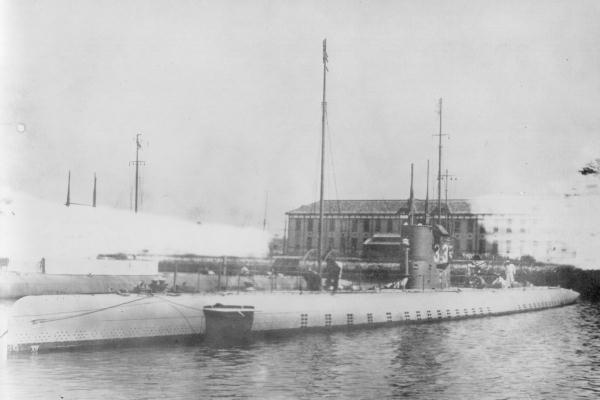 Constructed between 1919 and 1922, (''Ro-3''-class) submarines had a modified Bridge (nautical), bridge. Their Fiat diesel engines were unreliable, and like the F1 subclass they did not serve as the basis for future Japanese submarine classes.
* – Stricken 1932.
* – Stricken 1932.
* – Stricken 1932.
Constructed between 1919 and 1922, (''Ro-3''-class) submarines had a modified Bridge (nautical), bridge. Their Fiat diesel engines were unreliable, and like the F1 subclass they did not serve as the basis for future Japanese submarine classes.
* – Stricken 1932.
* – Stricken 1932.
* – Stricken 1932.
''Kaichū'' I Type (2 units)
 Constructed between 1917 and 1919, the I submarines were the first submarines built to Japanese requirements and designed specifically for service in the waters of East Asia and the Pacific Ocean, with greater Hull (ship), hull strength than was common in contemporary European submarines. They had four Bow (ship), bow torpedo tubes and two external tubes in trainable cradles on deck. and a 8 cm/40 3rd Year Type naval gun, deck gun.
* – Stricken 1932.
* – Stricken 1932.
Constructed between 1917 and 1919, the I submarines were the first submarines built to Japanese requirements and designed specifically for service in the waters of East Asia and the Pacific Ocean, with greater Hull (ship), hull strength than was common in contemporary European submarines. They had four Bow (ship), bow torpedo tubes and two external tubes in trainable cradles on deck. and a 8 cm/40 3rd Year Type naval gun, deck gun.
* – Stricken 1932.
* – Stricken 1932.
''Kaichū'' II Type (3 units)
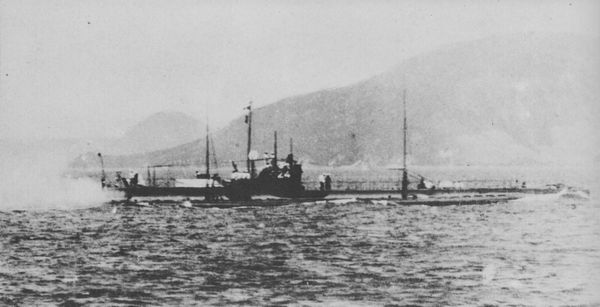 Constructed between 1918 and 1920, the II submarines had a longer range than the ''Kaichu'' I submarines, and the two trainable external torpedo tubes were replaced by two fixed external tubes.
* – Stricken 1932.
* – Stricken 1932, Hulk (ship), hulked 1934, and scrapped 1948.
* – Stricken 1933, Hulk (ship), hulked 1934, and scrapped 1948.
Constructed between 1918 and 1920, the II submarines had a longer range than the ''Kaichu'' I submarines, and the two trainable external torpedo tubes were replaced by two fixed external tubes.
* – Stricken 1932.
* – Stricken 1932, Hulk (ship), hulked 1934, and scrapped 1948.
* – Stricken 1933, Hulk (ship), hulked 1934, and scrapped 1948.
''Kaichū'' III Type (10 units)
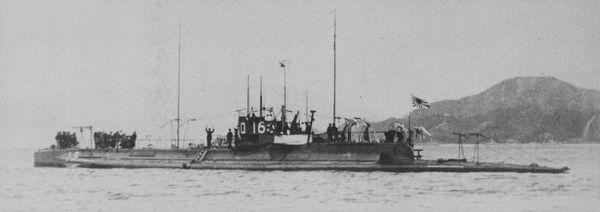 Constructed between 1919 and 1921, the III submarines had slightly improved performance and a greater diving depth than the ''Kaichu'' I and II Type submarines.
* – Stricken in 1933 and Hulk (ship), hulked in 1934.
* – Stricken in 1936.
* – Stricken in 1936 and Hulk (ship), hulked; scrapped in 1948.
* – Stricken in 1936 and Hulk (ship), hulked; scrapped in 1948.
* – Stricken in 1934; sold and Scuttling, scuttled as an artificial reef in 1935.
* – Stricken in 1934; sold and Scuttling, scuttled as an artificial reef in 1935.
* – Stricken in 1934.
* – Stricken and Hulk (ship), hulked in 1935.
* – Stricken and Hulk (ship), hulked in 1935.
* – Sank in 1923. Marine salvage, Salvaged and returned to service in 1926. Stricken and scrapped in 1936.
Constructed between 1919 and 1921, the III submarines had slightly improved performance and a greater diving depth than the ''Kaichu'' I and II Type submarines.
* – Stricken in 1933 and Hulk (ship), hulked in 1934.
* – Stricken in 1936.
* – Stricken in 1936 and Hulk (ship), hulked; scrapped in 1948.
* – Stricken in 1936 and Hulk (ship), hulked; scrapped in 1948.
* – Stricken in 1934; sold and Scuttling, scuttled as an artificial reef in 1935.
* – Stricken in 1934; sold and Scuttling, scuttled as an artificial reef in 1935.
* – Stricken in 1934.
* – Stricken and Hulk (ship), hulked in 1935.
* – Stricken and Hulk (ship), hulked in 1935.
* – Sank in 1923. Marine salvage, Salvaged and returned to service in 1926. Stricken and scrapped in 1936.
''Kaichū'' IV Type (3 units)
 The IV submarines were constructed between 1921 and 1922. The two external torpedo tubes of the previous ''Kaichū'' Types were deleted, but the ''Kaichū IV'' Type had larger torpedo tubes and carried heavier torpedoes.
* – Stricken and Hulk (ship), hulked in 1940; scrapped in 1948.
* – Stricken in 1940 and Hulk (ship), hulked; scrapped in 1947.
* – Sank in 1935, but Marine salvage, salvaged and returned to service. Stricken and Hulk (ship), hulked in 1940; scrapped in 1948.
The IV submarines were constructed between 1921 and 1922. The two external torpedo tubes of the previous ''Kaichū'' Types were deleted, but the ''Kaichū IV'' Type had larger torpedo tubes and carried heavier torpedoes.
* – Stricken and Hulk (ship), hulked in 1940; scrapped in 1948.
* – Stricken in 1940 and Hulk (ship), hulked; scrapped in 1947.
* – Sank in 1935, but Marine salvage, salvaged and returned to service. Stricken and Hulk (ship), hulked in 1940; scrapped in 1948.
''Kaichū'' V Type (4 units)
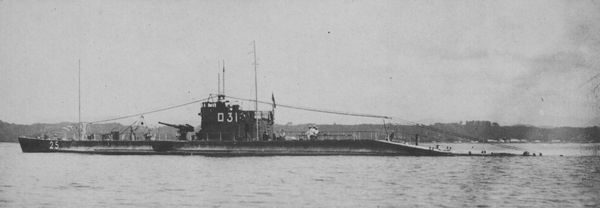 Constructed between 1921 and 1927, the IV submarines were designed for anti-commerce warfare and had heavier deck guns than previous ''Kaichū'' Type submarines.
* – Stricken in 1936 and Hulk (ship), hulked.
* – Stricken and Hulk (ship), hulked in 1942; scrapped in 1945.
* – Sank in 1923 during Sea trials, trials. Marine salvage, Salvaged, disassembled, reconstructed, and completed in 1927. Stricken and Hulk (ship), hulked in 1945. Scuttling, Scuttled on 5 April 1946.
* – Stricken and Hulk (ship), hulked in 1942; scrapped in 1945.
Constructed between 1921 and 1927, the IV submarines were designed for anti-commerce warfare and had heavier deck guns than previous ''Kaichū'' Type submarines.
* – Stricken in 1936 and Hulk (ship), hulked.
* – Stricken and Hulk (ship), hulked in 1942; scrapped in 1945.
* – Sank in 1923 during Sea trials, trials. Marine salvage, Salvaged, disassembled, reconstructed, and completed in 1927. Stricken and Hulk (ship), hulked in 1945. Scuttling, Scuttled on 5 April 1946.
* – Stricken and Hulk (ship), hulked in 1942; scrapped in 1945.
''Kaichū'' VI Type (2 units)
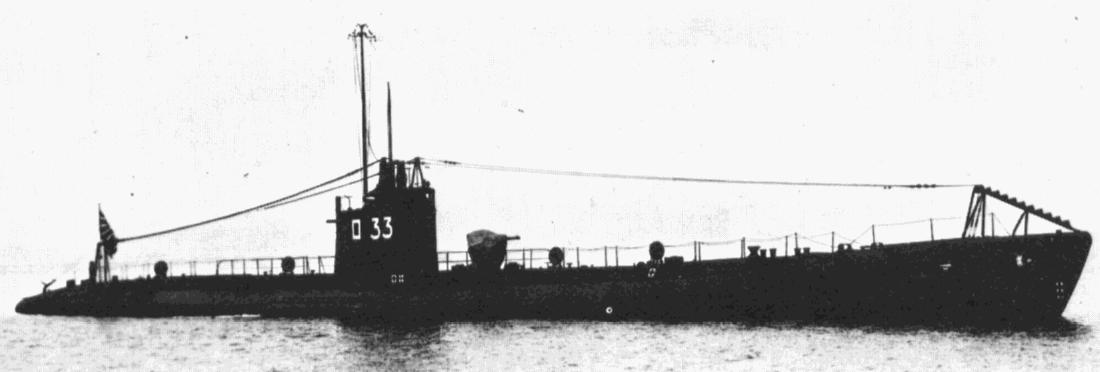 The VI submarines were double-hulled, medium-sized submarines. They were derived from the preceding ''Kaichū V'' Type and had improved performance. Constructed between 1933 and 1937, they served as prototypes for the major production ''Kaichu'' VII type constructed during World War II. They had a 8 cm/40 3rd Year Type naval gun, /40) deck gun and Type 95 torpedo, Type 95 (known to the Allies of World War II, Allies as the "Long Lance") torpedoes.
* – Sank in the Gulf of Papua on 7 August 1942. Sunk off Port Moresby on 29 August 1942 by .
* – Sunk off Makira, San Cristobal on 7 April 1943 by .
The VI submarines were double-hulled, medium-sized submarines. They were derived from the preceding ''Kaichū V'' Type and had improved performance. Constructed between 1933 and 1937, they served as prototypes for the major production ''Kaichu'' VII type constructed during World War II. They had a 8 cm/40 3rd Year Type naval gun, /40) deck gun and Type 95 torpedo, Type 95 (known to the Allies of World War II, Allies as the "Long Lance") torpedoes.
* – Sank in the Gulf of Papua on 7 August 1942. Sunk off Port Moresby on 29 August 1942 by .
* – Sunk off Makira, San Cristobal on 7 April 1943 by .
''Kaichū'' VII Type (18 units)
 The submarines were the Imperial Japanese Navy′s last medium submarines, and were enlarged and improved versions of the preceding ''Kaichū'' VI Type.
* – Sunk east of the Santa Cruz Islands on 25 August 1943 by .
* – Sunk east of Saipan on 13 June 1944 by .
* – Sunk southeast of Makira, San Cristobal on 22 January 1944 by .
* – Missing off the Gilbert Islands after 19 November 1943. Possibly sunk by west of Tarawa on 24 November 1943.
* – Sunk east of Wotje on 1 February 1944 by .
* – Sunk northeast of Kwajalein on 16 February 1944 by .
* – Sank east of Morotai on 3 October 1944. Sunk east of Okinawa on 23 March 1945 by .
* – Sank east of Espiritu Santo on 14 January 1944. Sunk east of Roi-Namur on 11 June 1944 by .
* – Sunk off the Volcano Islands on 26 February 1945 by aircraft from .
* – Sunk east of Eniwetok on 16 June 1944 by .
* – Sunk south of Chuuk Lagoon, Truk on 30 April 1944 by and .
* – Missing off Okinawa after 17 April 1945. Possibly sunk by aircraft from VC-92 on 29 April 1945.
* – Sunk northeast of the Palau Islands on 26 September 1944 by .
* – Sunk east of Saipan on 19 July 1944 by .
* – Missing southeast of Okinawa after 25 March 1945. Possibly sunk by southeast of Okinawa on 5 April 1945.
* – Sank east-southeast of Leyte on 10–11 February 1945. Surrendered at Sasebo in September 1945. Scuttling, Scuttled off the Goto Islands on 1 April 1946 as part of Operation Road's End.
* – Sunk west of Luzon on 7 February 1945 by .
* – Sunk west of Okinawa on 9 April 1945 by and .
The submarines were the Imperial Japanese Navy′s last medium submarines, and were enlarged and improved versions of the preceding ''Kaichū'' VI Type.
* – Sunk east of the Santa Cruz Islands on 25 August 1943 by .
* – Sunk east of Saipan on 13 June 1944 by .
* – Sunk southeast of Makira, San Cristobal on 22 January 1944 by .
* – Missing off the Gilbert Islands after 19 November 1943. Possibly sunk by west of Tarawa on 24 November 1943.
* – Sunk east of Wotje on 1 February 1944 by .
* – Sunk northeast of Kwajalein on 16 February 1944 by .
* – Sank east of Morotai on 3 October 1944. Sunk east of Okinawa on 23 March 1945 by .
* – Sank east of Espiritu Santo on 14 January 1944. Sunk east of Roi-Namur on 11 June 1944 by .
* – Sunk off the Volcano Islands on 26 February 1945 by aircraft from .
* – Sunk east of Eniwetok on 16 June 1944 by .
* – Sunk south of Chuuk Lagoon, Truk on 30 April 1944 by and .
* – Missing off Okinawa after 17 April 1945. Possibly sunk by aircraft from VC-92 on 29 April 1945.
* – Sunk northeast of the Palau Islands on 26 September 1944 by .
* – Sunk east of Saipan on 19 July 1944 by .
* – Missing southeast of Okinawa after 25 March 1945. Possibly sunk by southeast of Okinawa on 5 April 1945.
* – Sank east-southeast of Leyte on 10–11 February 1945. Surrendered at Sasebo in September 1945. Scuttling, Scuttled off the Goto Islands on 1 April 1946 as part of Operation Road's End.
* – Sunk west of Luzon on 7 February 1945 by .
* – Sunk west of Okinawa on 9 April 1945 by and .
Type L1 (''Ro-51'', ''Ro-52'')
 The (''Ro-51''-class) submarines were British L-class submarines built under license by Mitsubishi.
* – Hulk (ship), Hulked 1 April 1940.
* – Sunk on 29 October 1923, raised, repaired and returned to service. Sank again on 29 October 1925, raised and repaired. Stricken 1 April 1932.
The (''Ro-51''-class) submarines were British L-class submarines built under license by Mitsubishi.
* – Hulk (ship), Hulked 1 April 1940.
* – Sunk on 29 October 1923, raised, repaired and returned to service. Sank again on 29 October 1925, raised and repaired. Stricken 1 April 1932.
Type L2 (''Ro-53'', ''Ro-54'', ''Ro-55'', ''Ro-56'')
 The (''Ro-53''-class) submarines were similar to the Type L1 but with no broadside torpedo tubes and a change in the battery arrangement.
* – Hulk (ship), Hulked 1940.
* – Hulk (ship), Hulked 1940.
* – Stricken 1940.
* – Hulk (ship), Hulked 1940.
The (''Ro-53''-class) submarines were similar to the Type L1 but with no broadside torpedo tubes and a change in the battery arrangement.
* – Hulk (ship), Hulked 1940.
* – Hulk (ship), Hulked 1940.
* – Stricken 1940.
* – Hulk (ship), Hulked 1940.
Type L3 (''Ro-57'', ''Ro-58'', ''Ro-59'')
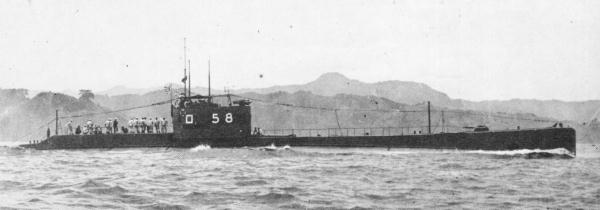 The (''Ro-57''-class) submarines were copies of the British submarine . Three units were built — , , — and all served as training submarines during World War II.
* – Scrapped in 1946.
* – Scrapped in 1946.
* – Scrapped in 1946.
The (''Ro-57''-class) submarines were copies of the British submarine . Three units were built — , , — and all served as training submarines during World War II.
* – Scrapped in 1946.
* – Scrapped in 1946.
* – Scrapped in 1946.
Type L4 (9 units)
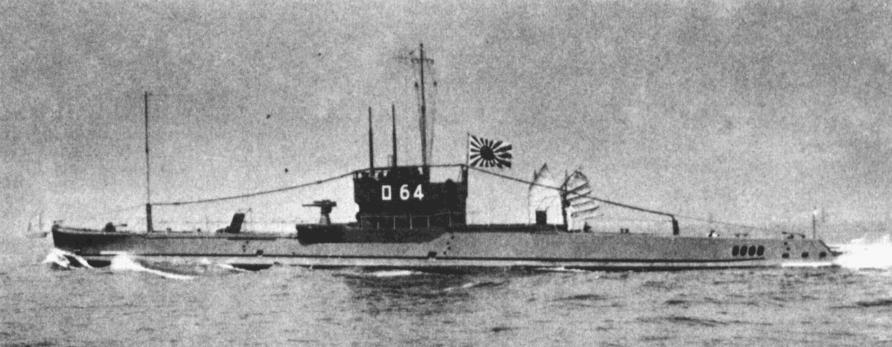 The (''Ro-60''-class) submarines were copies of the British submarine .
* – Wrecked on a reef off Kwajalein Atoll on 29 December 1941. Later blew up following an aircraft attack.
* – Sunk in the Bering Sea off Adak Island, Adak by on 31 August 1942.
* – Scuttling, Scuttled in the Seto Inland Sea in May 1946.
* – Scuttling, Scuttled in the Seto Inland Sea in May 1946.
* – Sunk by a Naval mine, mine in Hiroshima Bay on 12 April 1945.
* – Sank in a diving accident off Kiska on 3 November 1942.
* – Accidentally rammed and sunk by ''Ro-62'' off Wake Island on 17 December 1941.
* – Scrapped in 1946.
* – Scuttling, Scuttled in Wakasa Bay along with ''Ro-500'' and ''I-121'' on 30 April 1946.
The (''Ro-60''-class) submarines were copies of the British submarine .
* – Wrecked on a reef off Kwajalein Atoll on 29 December 1941. Later blew up following an aircraft attack.
* – Sunk in the Bering Sea off Adak Island, Adak by on 31 August 1942.
* – Scuttling, Scuttled in the Seto Inland Sea in May 1946.
* – Scuttling, Scuttled in the Seto Inland Sea in May 1946.
* – Sunk by a Naval mine, mine in Hiroshima Bay on 12 April 1945.
* – Sank in a diving accident off Kiska on 3 November 1942.
* – Accidentally rammed and sunk by ''Ro-62'' off Wake Island on 17 December 1941.
* – Scrapped in 1946.
* – Scuttling, Scuttled in Wakasa Bay along with ''Ro-500'' and ''I-121'' on 30 April 1946.
Ko Type (18 units)
 The (''Ro-100''-class) were medium-sized submarines for use as point-defense submarines.
* – Sunk by Naval mine, mine in the Bougainville Strait on 25 November 1943.
* – Sunk in Indispensable Strait by and a U.S. Navy patrol aircraft on 15 September 1943.
* – Missing off New Guinea after 9 May 1943.
* – Sank and off Makira, San Cristobal on 23 June 1943. Missing in the Solomon Islands (archipelago), Solomon Islands after 28 July 1943.
* – Sunk north of the Admiralty Islands on 23 May 1944 by .
* – Sunk north of the Admiralty Islands on 31 May 1944 by .
* – Sank in the Blanche Channel on 18 July 1943. Sunk north of the Admiralty Islands on 22 May 1944 by .
* – Missing after 6 July 1943 in the Solomon Islands (archipelago), Solomon Islands.
* – Sank in the Huon Gulf on 3 October 1943. Sunk north of the Admiralty Islands on 26 May 1944 by .
* – Sunk south-southwest of Okidaitōjima on 25 April 1945 by .
* – Possibly sank ''Daisy Moller'' in the Bay of Bengal on 3 December 1943. Sunk in the Bay of Bengal northeast of Madras on 11 February 1944 by , , and .
* – Sank ''Peshawur'' in the Bay of Bengal southeast of Madras on 23 December 1943 and in the Bay of Bengal near Calcutta on 16 March 1944. Sunk north of the Admiralty Islands on 10 June 1944 by .
* – Sunk north of Luzon on 11 February 1945 by .
* – Sank ''Marion Moller'' in the Bay of Bengal on 6 November 1944. Sunk north of Luzon on 13 February 1945 by .
* – Sunk west of Tinian on 17 June 1944 by and .
* – Sunk off Mindoro on 1 February 1945 by .
* – Sunk north of the Admiralty Islands on 24 May 1944 by .
* – Sunk southeast of Saipan on 17 June 1944 by U.S. Navy patrol aircraft.
The (''Ro-100''-class) were medium-sized submarines for use as point-defense submarines.
* – Sunk by Naval mine, mine in the Bougainville Strait on 25 November 1943.
* – Sunk in Indispensable Strait by and a U.S. Navy patrol aircraft on 15 September 1943.
* – Missing off New Guinea after 9 May 1943.
* – Sank and off Makira, San Cristobal on 23 June 1943. Missing in the Solomon Islands (archipelago), Solomon Islands after 28 July 1943.
* – Sunk north of the Admiralty Islands on 23 May 1944 by .
* – Sunk north of the Admiralty Islands on 31 May 1944 by .
* – Sank in the Blanche Channel on 18 July 1943. Sunk north of the Admiralty Islands on 22 May 1944 by .
* – Missing after 6 July 1943 in the Solomon Islands (archipelago), Solomon Islands.
* – Sank in the Huon Gulf on 3 October 1943. Sunk north of the Admiralty Islands on 26 May 1944 by .
* – Sunk south-southwest of Okidaitōjima on 25 April 1945 by .
* – Possibly sank ''Daisy Moller'' in the Bay of Bengal on 3 December 1943. Sunk in the Bay of Bengal northeast of Madras on 11 February 1944 by , , and .
* – Sank ''Peshawur'' in the Bay of Bengal southeast of Madras on 23 December 1943 and in the Bay of Bengal near Calcutta on 16 March 1944. Sunk north of the Admiralty Islands on 10 June 1944 by .
* – Sunk north of Luzon on 11 February 1945 by .
* – Sank ''Marion Moller'' in the Bay of Bengal on 6 November 1944. Sunk north of Luzon on 13 February 1945 by .
* – Sunk west of Tinian on 17 June 1944 by and .
* – Sunk off Mindoro on 1 February 1945 by .
* – Sunk north of the Admiralty Islands on 24 May 1944 by .
* – Sunk southeast of Saipan on 17 June 1944 by U.S. Navy patrol aircraft.
Third-class submarines
Sen'yu-Ko Type (10 units)
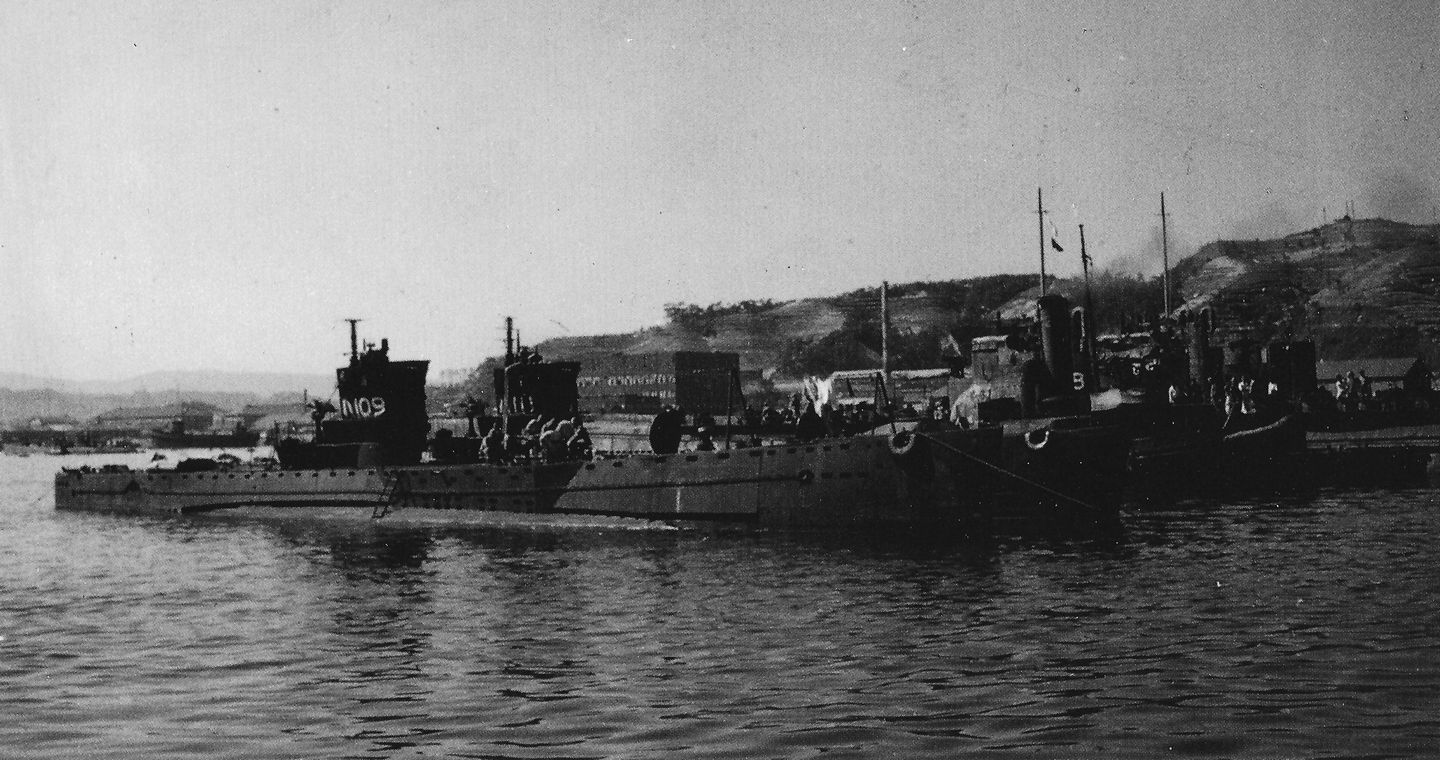 The were transport submarines built in 1944–1945. Several of this type were converted to tankers or to mother ships for the midget submarines. Ten of the 12 submarines laid down were completed.
* – Scrapped at Uraga or Scuttling, scuttled off Shimizu, Shizuoka, Shimizu (sources disagree) in October 1945.
* – Scrapped at Uraga or Scuttling, scuttled off Shimizu, Shizuoka, Shimizu (sources disagree) in October 1945.
* – Scuttled off the Gotō Islands on 1 April 1946 as part of Operation Road's End.
* – Scuttled off Shimizu, Shizuoka, Shimizu in October 1945.
* – Scuttled off the Goto Islands on 1 April 1946 as part of Operation Road's End.
* – Scuttled off the Goto Islands on 1 April 1946 as part of Operation Road's End.
* – Scuttled off the Goto Islands on 1 April 1946 as part of Operation Road's End.
* – Scuttled off the Goto Islands on 1 April 1946 as part of Operation Road's End.
* – Scuttled off the Goto Islands on 1 April 1946 as part of Operation Road's End.
* – Scuttled off the Goto Islands on 1 April 1946 as part of Operation Road's End.
The were transport submarines built in 1944–1945. Several of this type were converted to tankers or to mother ships for the midget submarines. Ten of the 12 submarines laid down were completed.
* – Scrapped at Uraga or Scuttling, scuttled off Shimizu, Shizuoka, Shimizu (sources disagree) in October 1945.
* – Scrapped at Uraga or Scuttling, scuttled off Shimizu, Shizuoka, Shimizu (sources disagree) in October 1945.
* – Scuttled off the Gotō Islands on 1 April 1946 as part of Operation Road's End.
* – Scuttled off Shimizu, Shizuoka, Shimizu in October 1945.
* – Scuttled off the Goto Islands on 1 April 1946 as part of Operation Road's End.
* – Scuttled off the Goto Islands on 1 April 1946 as part of Operation Road's End.
* – Scuttled off the Goto Islands on 1 April 1946 as part of Operation Road's End.
* – Scuttled off the Goto Islands on 1 April 1946 as part of Operation Road's End.
* – Scuttled off the Goto Islands on 1 April 1946 as part of Operation Road's End.
* – Scuttled off the Goto Islands on 1 April 1946 as part of Operation Road's End.
Sentaka-Ko Type (10 units)
 The (''Submarine High speed-Small type'') were small, high-speed submarines constructed in 1944–1945 to defend the Japanese archipelago, Japanese Home Islands from an Operation Downfall, Allied invasion. Of the 79 boats planned, only ten were completed.
* – Sunk as a target off the Gotō Islands on 1 April 1946 along with ''I-402'' as part of Operation Road's End.
* – Scuttled off the Gotō Islands on 1 April 1946 as part of Operation Road's End.
* – Scuttled off the Gotō Islands on 1 April 1946 as part of Operation Road's End.
* – Ran aground in Aburatsu Bay on 29 October 1945, salvaged and then scrapped August to October 1948.
* – Scuttled in the Seto Inland Sea on 9 May 1946 as part of Operation Bottom.
* – Scuttled off Sasebo Bay on 5 April 1946.
* – Scuttled off the Gotō Islands on 1 April 1946 as part of Operation Road's End.
* – Deliberately run aground on Ganryū-jima on 18 August 1945. Blown up on 11 November 1945 by the US Navy. Salvaged from August to November 1946 and then scrapped.
* – Scuttled off Sasebo Bay on 5 April 1946.
* – Scuttled off Sasebo Bay on 5 April 1946.
The (''Submarine High speed-Small type'') were small, high-speed submarines constructed in 1944–1945 to defend the Japanese archipelago, Japanese Home Islands from an Operation Downfall, Allied invasion. Of the 79 boats planned, only ten were completed.
* – Sunk as a target off the Gotō Islands on 1 April 1946 along with ''I-402'' as part of Operation Road's End.
* – Scuttled off the Gotō Islands on 1 April 1946 as part of Operation Road's End.
* – Scuttled off the Gotō Islands on 1 April 1946 as part of Operation Road's End.
* – Ran aground in Aburatsu Bay on 29 October 1945, salvaged and then scrapped August to October 1948.
* – Scuttled in the Seto Inland Sea on 9 May 1946 as part of Operation Bottom.
* – Scuttled off Sasebo Bay on 5 April 1946.
* – Scuttled off the Gotō Islands on 1 April 1946 as part of Operation Road's End.
* – Deliberately run aground on Ganryū-jima on 18 August 1945. Blown up on 11 November 1945 by the US Navy. Salvaged from August to November 1946 and then scrapped.
* – Scuttled off Sasebo Bay on 5 April 1946.
* – Scuttled off Sasebo Bay on 5 April 1946.
Midget submarines
This class includes the smallest of the Japanese submarines, from midget submarines to manned torpedoes often used for suicide attacks.''Ko-Hyoteki'' Type (50 units)
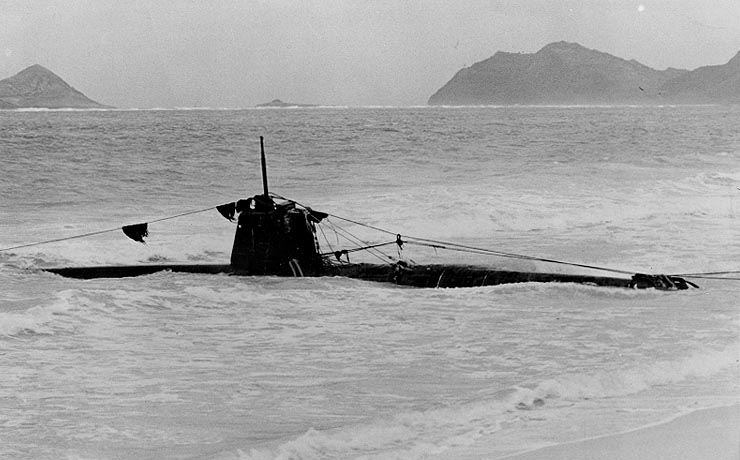 The class of Japanese midget submarines had hull numbers but no names. For simplicity, they are most often referred to by the hull number of the mother submarine. Thus, the midget carried by was known as the I-16 midget. The midget submarine hull numbers beginning with the character "HA", which can only be seen on a builder's plate inside the hull.
Fifty Ko-hyoteki were built. The "A Target" name was assigned as a ruse – if their design was prematurely discovered by Japan's foes, the Japanese Navy could insist that the vessels were battle practice targets. They were also called "tubes" and other slang names.
The class of Japanese midget submarines had hull numbers but no names. For simplicity, they are most often referred to by the hull number of the mother submarine. Thus, the midget carried by was known as the I-16 midget. The midget submarine hull numbers beginning with the character "HA", which can only be seen on a builder's plate inside the hull.
Fifty Ko-hyoteki were built. The "A Target" name was assigned as a ruse – if their design was prematurely discovered by Japan's foes, the Japanese Navy could insist that the vessels were battle practice targets. They were also called "tubes" and other slang names.
''Kairyū'' Type (250 units)
 The was a class of midget submarines designed in 1943–1944, and produced from the beginning of 1945. These submarines were meant to meet the invading American Naval forces upon their anticipated approach of Tokyo.
Over 760 of these submarines were planned, and by August 1945, 250 had been manufactured, most of them at the Yokosuka shipyard.
These submarines had a two-man crew and were fitted with an internal warhead for suicide missions.
The was a class of midget submarines designed in 1943–1944, and produced from the beginning of 1945. These submarines were meant to meet the invading American Naval forces upon their anticipated approach of Tokyo.
Over 760 of these submarines were planned, and by August 1945, 250 had been manufactured, most of them at the Yokosuka shipyard.
These submarines had a two-man crew and were fitted with an internal warhead for suicide missions.
''Kaiten'' Type (400 units)
Notes
Bibliography
* Baldwin, Hanson W. ''Sea Fights and Shipwrecks.'' Hanover House; 1956, NY, USA. * Boyne, Walter. ''Clash of Titans.'' Simon and Schuster; 1995. NY, USA. . * Hasimoto, Mochisura. ''Sunk; The Story of the Japanese Submarine Fleet, 1941–1945.'' Henry Holt, 1954; Reprinted by Progressive Press, NY, 2010. . * Jentschura, Hansgeorg; Dieter Jung, Peter Mickel. ''Warships of the Imperial Japanese Navy, 1869–1945.'' United States Naval Institute, Annapolis, Maryland, USA, 1977. . * Morris, Richard Knowles, PhD, ''Who Built Those Subs?'', Naval History Magazine, United States Naval Institute Press, October 1998, 125th Anniversary Issue. * Orita, Zenji. ''I-Boat Captain''. Major Books Pub.; 1976. * ''International Directory of Company Histories'', Volume 86. Published July 2007. Gale Group/St. James Press. * ''The Klaxon'', official U.S. Navy submarine force newsletter. Published by the ''Nautilus Memorial Force Library Force Library and Museum'', Summer issue, 1992. Account of Arthur Busch/Du Busc's key role pioneering America's first submarines for John Philip Holland – and the first five Imperial Japanese Naval Submarines on behalf of the newly formed Electric Boat Company.External links
Submarine Pioneers
{{DEFAULTSORT:Imperial Japanese Navy Submarines Submarines of the Imperial Japanese Navy, Imperial Japanese Navy Submarine warfare in World War II